
Unusual and Exotic Vine Seeds From Around the World
Our list of Exotic and Unusual Vine Seeds from around
the world.
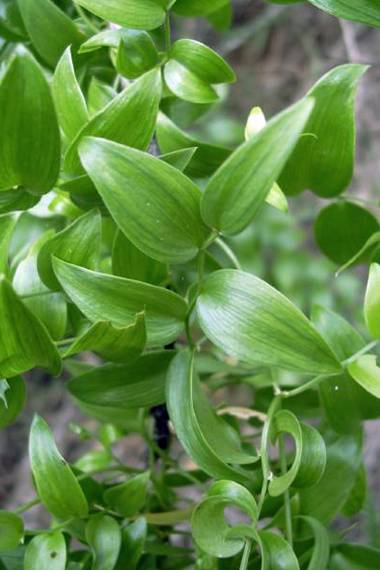
LET095 Bridal Creeper ( Asparagus asparagoides ‘Smilax’ )
Originally native to eastern and southern Africa, this easily grown, scrambling vine is popular worldwide as an ornamental and widely cultivated as an ornamental vine. It is commonly used in floral arrangements or home decorating.
It is a popular garden plant, and it can attract birds to the garden with its red berries. Best known under the name smilax, it is often used in floral arrangements and in bridal bouquets, and is a popular container plant for home decorating. Roots serve a medicinal purpose as a balm for sore eyes, as a purgative and as a fertility charm for cattle.
You can use it as a ground cover, allow it to cascade over a retaining wall or from a hanging basket. It can also be trained up a small trellis. It is suitable for containers and can be grown indoors. Once established, it is moderately drought resistant. The plant can be damaged and appears to be killed by frost, it prefers partly shaded areas.
Zone 9 outside, or grow inside in cooler zones.
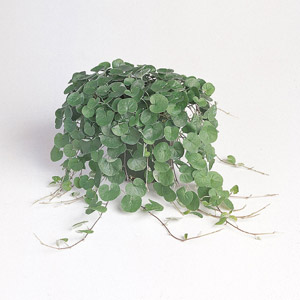
TPF231 Emerald Falls MSP ( Dichondra repens )
Annual. Vigorous and easy to grow, this Dichondra boasts thick, super-soft deep green leaves (about an inch wide) arising profusely on very well-branched plants that need no pinching. Emerald Beauty will cascade about 3 feet from your baskets, windowboxes, or other containers, but it will also form a nicely domed shape that fills the available space beautifully!
Very heat- and drought-tolerant, it recovers quickly even if wilted, and looks fresh all season long. Try it in a large container behind super-cascading Silver Falls, or among trailing flowering plants from Periwinkle to Sweet Pea.
Emerald Falls thrives in full sun and well-drained soil. Start the seeds indoors in late winter (about 6 to 8 weeks before last anticipated frost) and then set out when the weather warms up in spring.
Multiseed Pellets ( each pellet contains 6-8 seeds ).
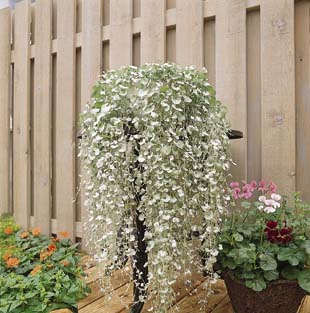
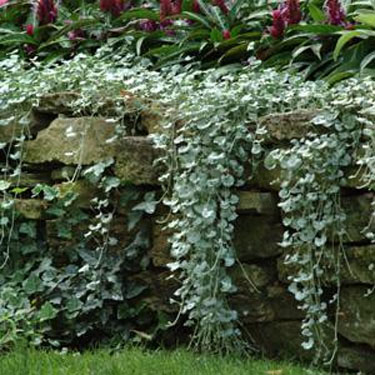
3650 Silver Falls ( Dichondra Argentea )
If you like the dark green Emerald Falls Dichondra, then you will also love the silvery foliage of Silver Falls Dichondra. It is a wonderful pick for hanging baskets or use as a stunning low growing ground cover to use around the other plants. You will love how the contrasting foliages set each other off! Dichondra is commonly called Ponyfoot, and this silver Ponyfoot is a must-have for the summer display.
Silver Falls is characterized by silvery leaves, glistening silver stems, and a cascading habit that can spread up to 5 feet. Easy and fast growing from seeds, this Dichondra plant is simply one of the showiest accents around for all your containers and bare garden spots. The 3/4 – 1 inch leaves have a thick, super-soft texture and neat fan shape. Just like Emerald Falls, this adorable foliage plant needs no pinching.
Quicker than you can say Silver Falls, this cascading beauty will be 3 to 5 feet long, but only growing 3 – 5 inches tall. It is also very heat and drought tolerant making it the perfect plant for sunny locations. Silver Falls recovers quickly even if wilted, and looks fresh all season long.
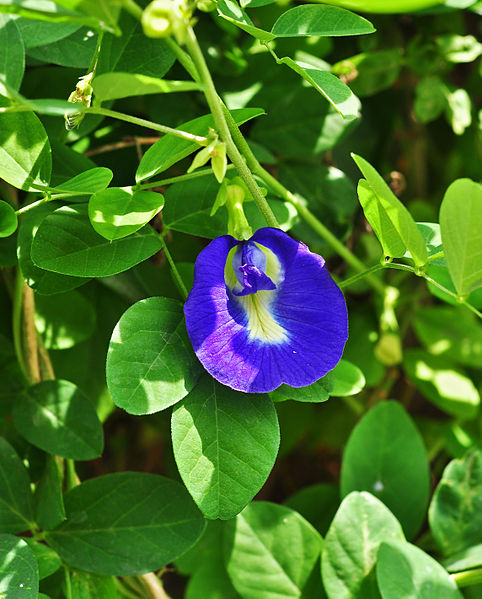
D9899 Blue Pea Vine ( Clitoria ternatea )
One of our favorite plants for hanging baskets, blooms in only 6 weeks from seed. A fast growing climber with beautiful blue and sometimes white flowers. It can be grown in baskets and containers, and blooms
all year, or it can be grown outside on trellis or fence. A
drought hardy plant which can be used as a fast growing screen
along fences. Attracts butterflies. Produces a small pea type
seed which is used as food in the Phillipines.
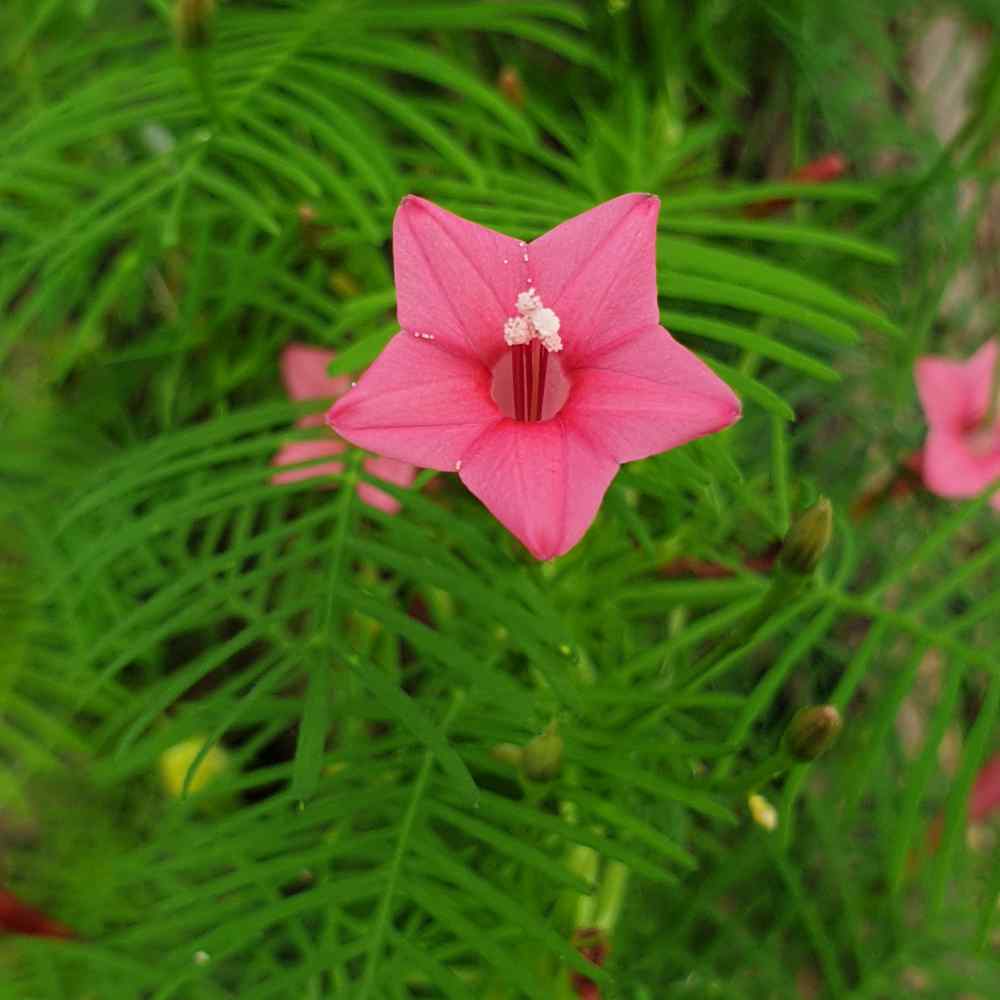
SF402 Cypress Vine Rose ( Ipomoea Pennata Rose )
Hummingbirds cannot resist Cypress Vines! The star-shaped rose colored blooms are rich in nectar, and hummingbirds love them. To bring hummingbirds to your garden, start Cypress Vine flower seeds and grow this twining vine that grows easily and quickly. Not surprisingly, the Ipomoea vine is also sometimes called Hummingbird Vine or Star Glory, and the common names are very appropriate. The blooms are not only gorgeous, but the foliage is as well. It is feathery, bright green and thick. Cypress Vines grow so quickly that they are great for creating a concealing screen or providing a spot of shade when they are given a trellis or pergola to climb. A wonderful summer addition to any landscape!
Cypress Vine plants grow well in full sun or partial shade. They are not picky about the quality of soil, but it does need to have good drainage. Once the Cypress Vine Star Glory plant is established well, it can withstand periods of drought. However, it will grow faster and have more blooms with regular water. Deadheading the spent blooms will encourage a prolonged bloom season. Blooms will usually start the first of summer and continue until fall. In some warm regions, Cypress Vine will grow as a perennial.
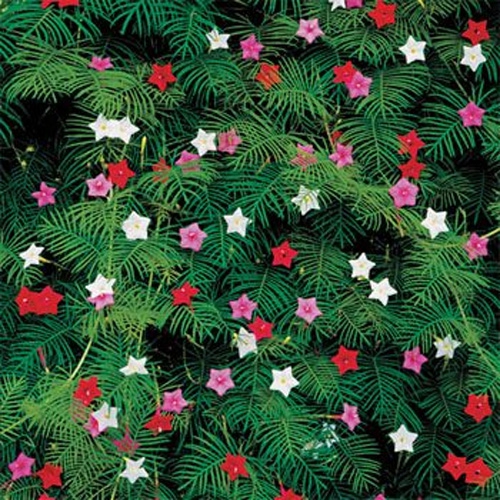
SF372 Cypress Vine Mix ( Ipomoea Pennata Mix )
A favorite of gardeners, this annual is related to Morning Glories. It grows as easily from Cypress Vine flower seed and as quickly as Morning Glories, but it also offers some additional features. Cypress Vines have a wonderful, feathery foliage that adds interest and texture. Morning Glories have lovely heart-shaped leaves, but they tend to blend in to each other and not stand out much. Not so with Cypress Vine foliage. It’s attractive and interesting even when not in bloom. This Cypress Vine flower seed mix will grow blooms that are white, bright red, and rose, and they are produced in mass! They stay opened all day which is great for the hummingbirds who absolutely love their nectar. In fact, the Ipomoea vine also is commonly called Hummingbird Vine and Star Glory.
Cypress Vine plants grow well in full sun or partial shade. They are not picky about the quality of soil, but it does need to have good drainage. Once the Cypress Vine Star Glory plant is established well, it can withstand periods of drought. However, it will grow faster and have more blooms with regular water. Deadheading the spent blooms will encourage a prolonged bloom season. Blooms will usually start the first of summer and continue until fall. In some frost free areas, Cypress Vine will grow as a perennial.
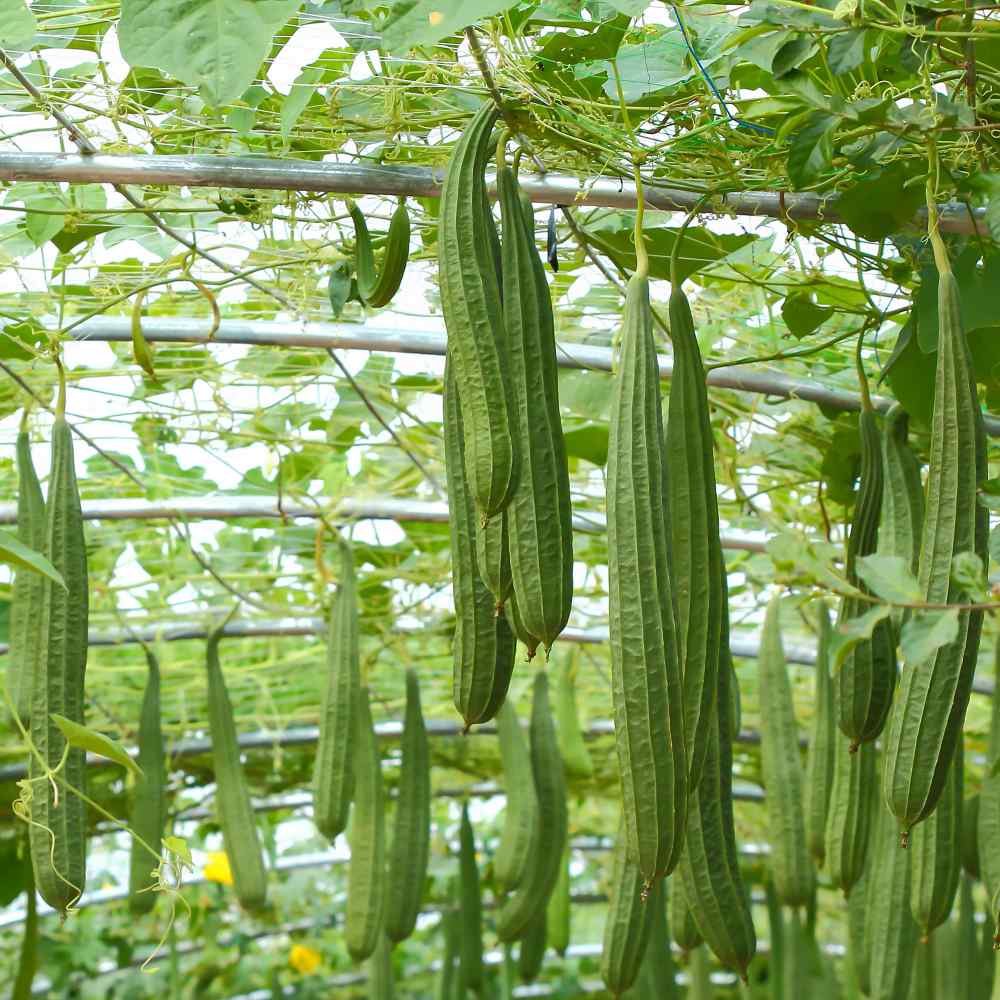
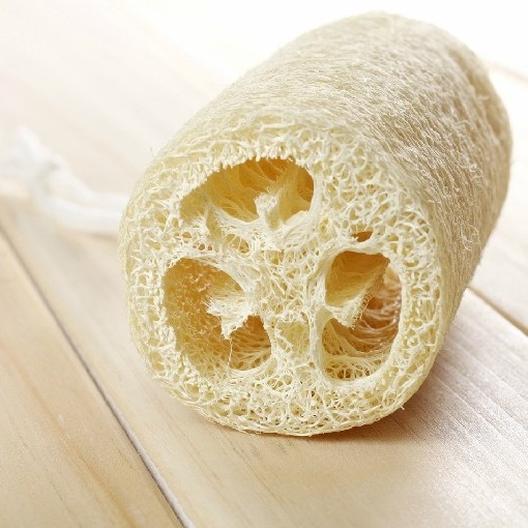
RGS031 Common Luffa Sponge
The Loofah Gourd is a member of the Cucurbitaceae ( Gourd ) family. The Loofah is spelled several different ways, i.e., Lofah, Luffa or Lufa. It’s commonly known as the Washrag Gourd. It is the only plant known that can be raised and used as a sponge.
The sponges are very versatile in that they can be used for bathing, washing dishes or scrubbing. The Loofah is widely used for bathing to invigorate the skin as well as gift giving and crafts.
It is a very fast growing annual that produce vines up to twelve feet or more. I have seen them grow over 20 ft. high in trees and produce dozens of gourds per plant.
When fully matured, you can peel off the dried and crisp outer shell to expose the fibrous sponge. To clean your Loofah you wash it in clean water and then soak it in a solution of bleach and water and allow to dry in the sun. Loofah sponges will last a long time if washed and allowed to dry after each use.
Here are some helpful links on growing and harvesting the loofa sponge:
How to grow natural loofa sponges.
How to harvest your luffa and turn them into sponges.
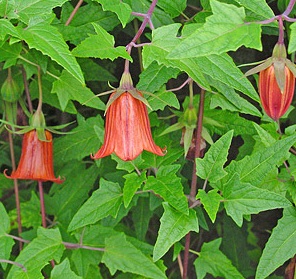
TRN615 Canary Bellflower ( Canarina canariensis )
Perennial. A scrambling, creeping or climbing perennial with pointed leaves and beautiful red to orange, bellshaped flowers followed by edible berries. It is native to the understory of humid laurel forests in the western Canary Islands, where it flowers during the winter and dies down to its tuberous base in the dry summer months.
In cultivation, with sufficient moisture available it will flower through the summer. Well mulched and with excellent drainage it is hardy to USDA Zone 8.
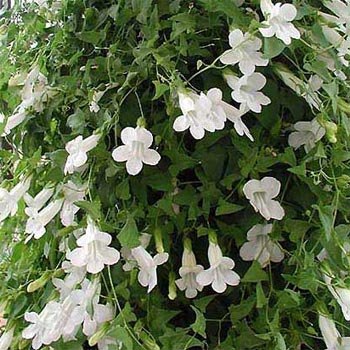
TWT182 White Climbing Snapdragon ( Asarina scandens )
Asarina seeds are easy to grow, and soon the garden will have a gorgeous vertical addition! This Climbing Snapdragon, has large 2-inch trumpet-shaped white flowers that begin blooming in early summer and continues until frost. Small emerald green leaves are covered in a mass of delicate snow white blooms on twining stems that reach a height of 10 feet in full to partial shade. Asarina Scandens grows well in containers and baskets, and will also grow happily climbing up a trellis.
Climbing Snapdragon grows fast and easily. Despite how delicate it appears, it is quite tough. Cut Asarina back if it gets shabby and it will bounce right back. Plant the seeds in rich soil with average moisture. It is considered to be a tender-perennial, and in frost free zones, it will be evergreen. With a frost, Asarina vine will die back, but it may have new shoots in the spring. Give it a top dressing of compost once a year in early spring.
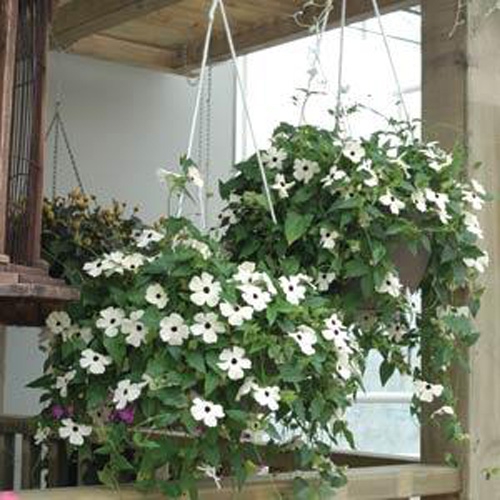
LET189 Sunrise White Thunbergia ( Thunbergia Alata )
Gardeners fall in love with Thunbergia vine. Easily established from Thunbergia seeds, this annual is commonly called Black-Eyed Susan Vine. This white Black Eyed Susan vine is very quick to bloom, offers a super-long season of color, and has a classic color pattern that complements everything in the garden! The blooms reach about 1 1/2 inches in diameter when open wide. The petals are white, surrounding a bold black eye on most blooms. The blooms are profuse smothering the vine over a long bloom season clear up until frost.
White Thunbergia vines grows best in full sun. They needs average, well-drained soil. Plant seedlings 3 inches away from supports. Netting or strings make good trellis material. Solid fencing or large posts will need trellis material for the vine to climb. Space plants 8 – 12 inches apart. Pinch the tips of young Black-Eyed Susan plants to encourage branching. In areas of no frost, white Thunbergia vine will grow as a perennial. In colder climates, grow it as an annual, sowing the Thunbergia seeds each year. If grown in a container, Thunbergia Black Eyed Susan vine can be wintered indoors in a bright, sunny window.
It is recommended to soak the Black-eyed Susan vine seeds over night in tepid water. Following the soaking, sow Thunbergia seeds outdoors after the last frost in prepared seed bed. Or, to get a jump start on the growing season, sow Thunbergia Alata seeds indoors 6 – 8 weeks before outdoor planting. Thunbergia flower seeds germinate better in darkness.
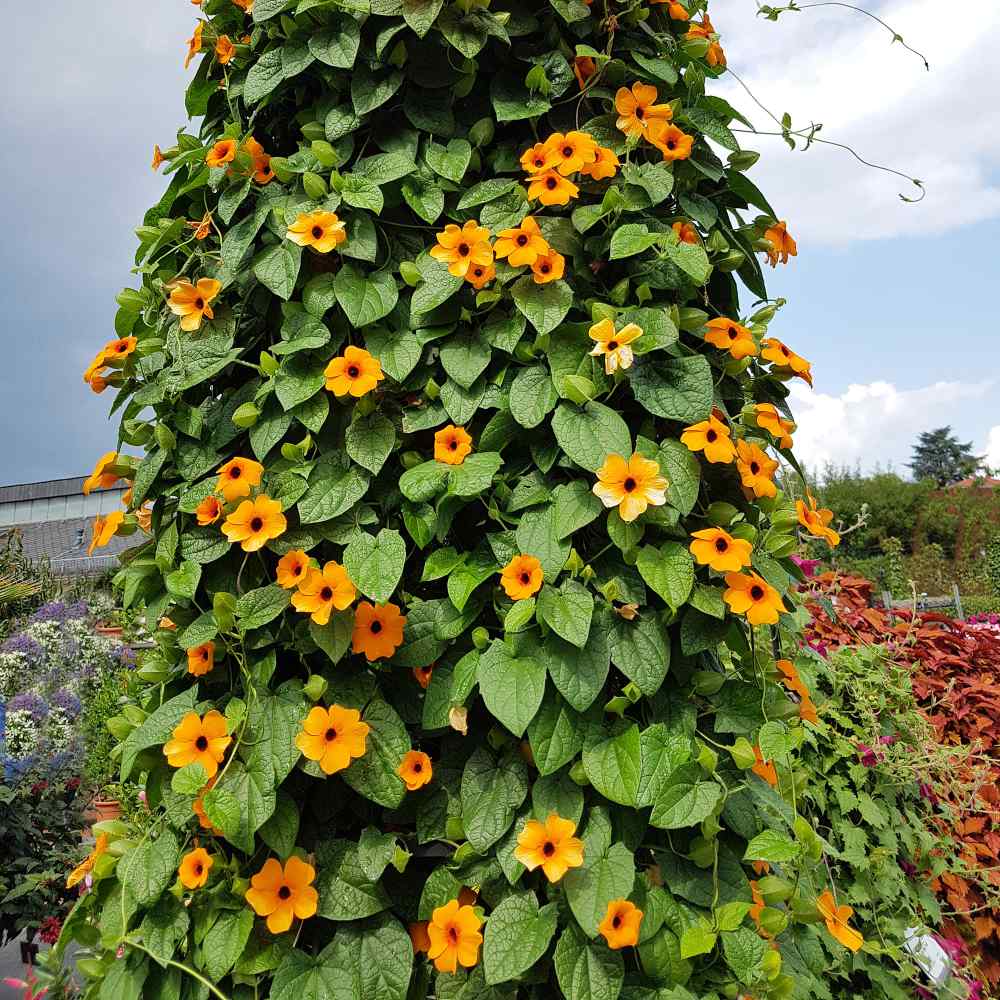
LET262 Sunrise Orange Thunbergia ( Thunbergia Alata )
The orange Black Eyed Susan vine features 1 – 2 inch orange blooms, many with black eyes, against large, heart-shaped foliage. It’s a fast climber, and it will adorn a rustic gate, mailbox, flagpole base, or trellis with a twining vine, lush foliage and masses of blooms. Thunbergia orange vines makes wonderful privacy screens if they are grown at the base of chain-link fencing.
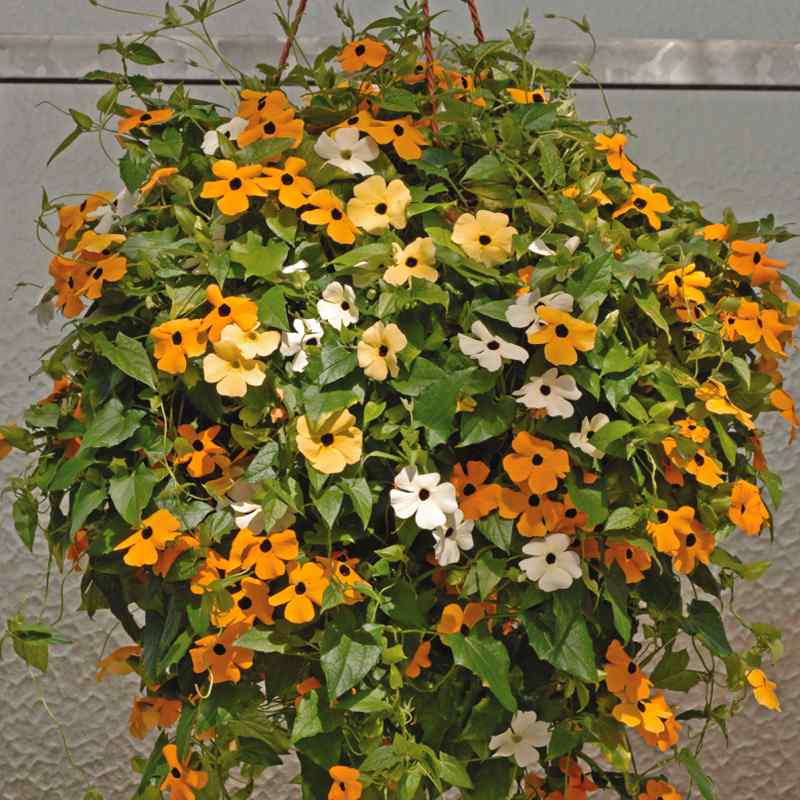
LET190 Sunrise Mix Thunbergia ( Thunbergia Alata Mix )
Gardeners fall in love with Thunbergia vine. Easily established from Thunbergia seeds, this annual is commonly called Black-Eyed Susan Vine. This Black Eyed Susan vine is very quick to bloom, offers a super-long season of color, and has a classic color pattern that complements everything in the garden! The blooms reach about 1 1/2 inches in diameter when open wide. The petals are a mix of white, yellow and orange, surrounding a bold black eye on most blooms. The blooms are profuse smothering the vine over a long bloom season clear up until frost.
Thunbergia vines grows best in full sun. They needs average, well-drained soil. Plant seedlings 3 inches away from supports. Netting or strings make good trellis material. Solid fencing or large posts will need trellis material for the vine to climb. Space plants 8 – 12 inches apart. Pinch the tips of young Black-Eyed Susan plants to encourage branching. In areas of no frost, Thunbergia vines will grow as a perennial. In colder climates, grow it as an annual, sowing the Thunbergia seeds each year. If grown in a container, Thunbergia Black Eyed Susan vine can be wintered indoors in a bright, sunny window.
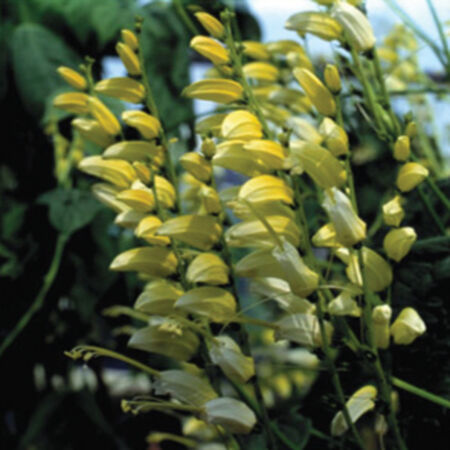
TWT130 Citronella ( Mina lobata )
This beautiful vine attract hordes of hummingbirds and butterflies.
The Mina Citronella is a citrus yellow flower with long stems that is a rare variety of Mina Lobata and is said to be used for keeping mosquitos away ( we cannot verify how effective the plant is for this use yet ). This variety starts out with dark yellow buds that transforms to a citrus yellow, and ending with creamy white tips. This variety’s blossoms are held upright on long stems making a nice contrast against its dark green foliage. This easy to grow spectacular vine grows to 15 feet in full sun. Mina’s climbing vine is super in baskets and will bloom in 10 weeks from seed.
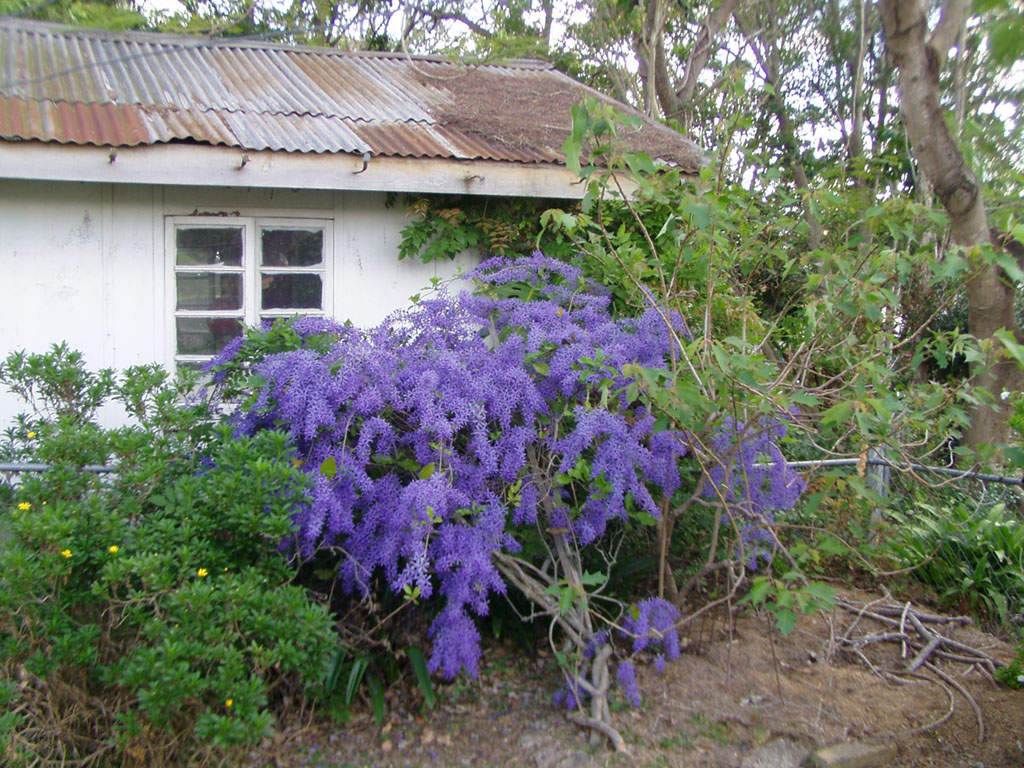
SF333 Queens Wreath ( Petrea volubilis )
Queen’s Wreath is a glorious vine from Mexico that blooms long tresses of lavender blue blossoms that resemble tiny orchids. It is one of the most distinct and beautiful of the cultivated climbers. It looks somewhat similar to a tropical Wisteria. It is a fast-growing woody vine with a grey bark, a strong climber, and will attain great height and cover a considerable area if left unpruned.
An evergreen clambering and twining vine that in Central America can grow to great heights with support (25-40 feet) but in cultivation is more often seen as a espalier subject or a smaller vine though plants to 20 feet have been noted in Southern California.
It has long elliptic shaped leaves to 8 inches long that are dark green above and lighter below and rough to the touch like sandpaper. Several times a year ( spring through early summer and again fall into winter ) appear the 1 foot long terminal raceme of flowers, resembling that of wisteria.
The tubular blue flowers only last a few days but the larger and more showy bluish purple calyces remain, fading first to blue and finally to a pale gray color. The dark green foliage, with its gritty texture, acts as a foil to the pale calyces, so that the floral display appears as pale stars on a dark background. The flowers are attractive to bees, butterflies and hummingbirds and useful in flower arrangements but cut only at the base of the raceme as the flowers wilt if part of the woody vine is left attached.
Plant this beautiful vine in full sun or light shade in a well-drained soil and give regular irrigation throughout the warmer months of the year.
Said to be cold hardy ( without dying )to upper 20’s. Zone is probably 8b-11.
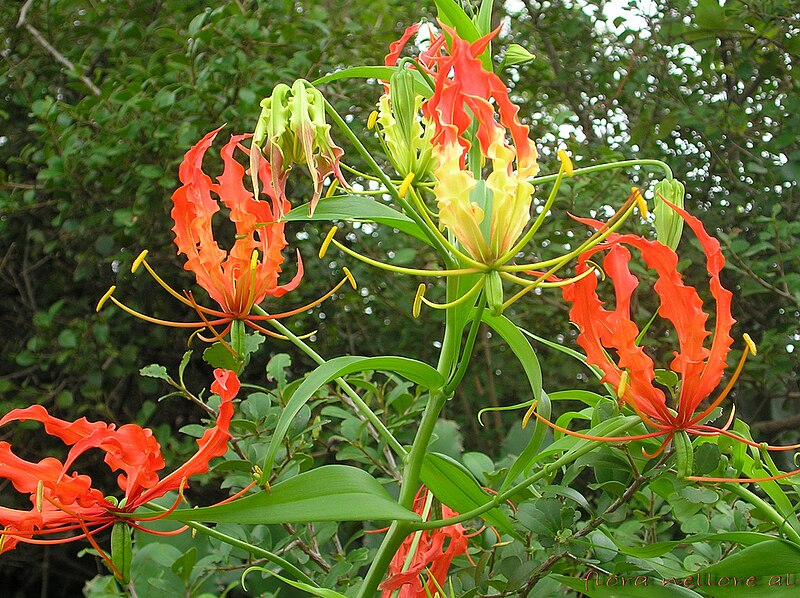
BM20 Glory Lily (
Gloriosa rothschildiana )
Native toSouth Africa and India, the name means “full of
glory”, appropriate for such showy exotics. These tender
perennials form sizeable clumps and will grow 4 to 6 feet in a
season. Vines are light weight, so do not require stout
supports. Easy to grow and excellent for summer decks, and
inside in sunrooms and greenhouses where there is sufficient
room for vining plants. Hardiness: 9-11, elsewhere lift in fall
and store indoors or grow as houseplant, height: 4-6 feet,
vining, color: flashy yellow and ruby flowers with wavy,
swept-back petals.
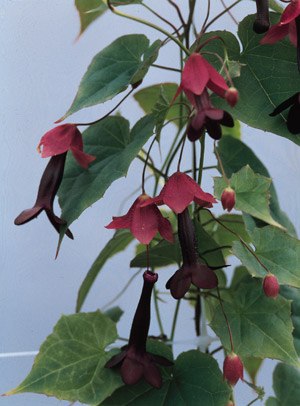
TRN942 Purple Rain ( Rhodochiton )
Grow Purple Rain for an exotic vine that will have everyone’s attention! It has heart-shaped leaves and dark purple bell-shaped flowers that dangle from thread-like stems. Bell Vine uses include baskets where it will cascade over the edges and look stunning or give it a trellis where it will grow with support up to 120 inches in height.
Purple Bells needs rich, well-drained soil and full sun to partial shade although it prefers afternoon shade in hotter climates. Purple Bells bloom from late spring to late fall. Annual
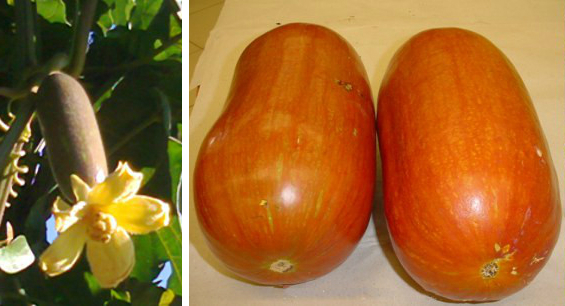
D8566 Cassabanana ( Sicana odorifera )
Young stems are hairy. The leaves are gray-hairy, rounded-cordate or rounded kidney-shaped, to 1 foot wide, deeply indented at the base, 3-lobed, with wavy or toothed margins.
Flowers are white or yellow, urn-shaped, 5-lobed, solitary, the male 3/4 inch long, the female about 2 inches long.
Renowned for its strong, sweet, agreeable, melon-like odor, the striking fruit is ellipsoid or nearly cylindrical, sometimes slightly curved; 12 to 24 inches in length, 3 to 4 inches in diameter, hard-shelled, orange-red, maroon, dark-purple with tinges of violet, or entirely jet-black; smooth and glossy when ripe, with firm, orange-yellow or yellow, cantaloupe-like, tough, juicy flesh.
The cassabanana is believed native to Brazil but it has been spread throughout tropical America.
Venezuelans and Brazilians are partial to the vine as an ornamental, but in Cuba, Puerto Rico and Mexico it is grown for the usefulness of the fruit.
A high temperature during the fruiting season is needed to assure perfect ripening. Brazilians train the vine to grow over arbors or they may plant it close to a tree. However, if it is allowed to climb too high up the tree there is the risk that it may smother and kill it.
The cassabanana remains in good condition for several months if kept dry and out of the sun.
The fruit has high market value in Puerto Rico. It is cut up and sold by the piece, the price being determined by weight.
The ripe flesh, sliced thin, is eaten raw, especially in the summer when it is appreciated as cooling and refreshing. However, it is mainly used in the kitchen for making jam or other preserves. The immature fruit is cooked as a vegetable or in soup and stews.
People like to keep the fruit around the house, and especially in linen- and clothes-closets, because of its long-lasting fragrance, and they believe that it repels moths. It is also placed on church altars during Holy Week.
Medicinal Uses: In Puerto Rico, the flesh is cut up and steeped in water, with added sugar, overnight at room temperature so that it will ferment slightly. The resultant liquor is sipped frequently and strips of the flesh are eaten, too, to relieve sore throat. It is believed beneficial also to, at the same time, wear a necklace of the seeds around the neck.
The seed infusion is taken in Brazil as a febrifuge, vermifuge, purgative and emmenagogue. The leaves are employed in treating uterine hemorrhages and venereal diseases. In Yucatan, a decoction of leaves and flowers (2 g in 180cc water) is prescribed as a laxative, emmenagogue and vermifuge, with a warning not to make a stronger preparation inasmuch as the seeds and flowers yield a certain amount of hydrocyanic acid.
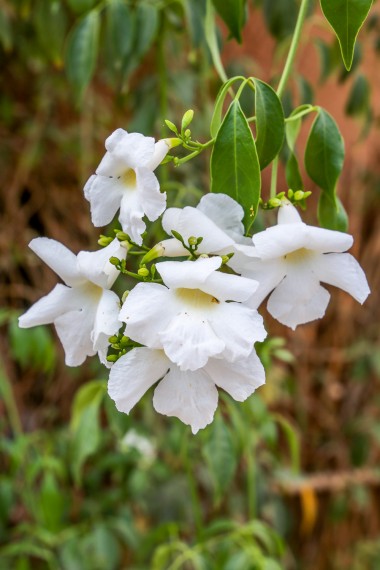
SF301 White Bower Vine ( Pandorea jasminoides alba )
Pandorea is an excellent vine to grow in large containers. When outfitted with a trellis these make beautiful portable screens of foliage that can be moved around as needed to block an eyesore or just to create a romantic mood.
Several times a year this talented vine covers inself in large fragrant flowers causing you to congratulate yourself for having the luck to grow this beautiful vine.
Graceful form, attractive foliage and a rather rapid rate of growth make pandorea a perfect vine for covering arbors, trellises, summer houses and other structures in warm climates. Bower vine looks great growing on a tree with the flowers cascading down the trunk.
Bower vine, or pandorea, is a bushy, twining vine with woody stems and pinnate, evergreen leaves. The 5-9 lance shaped leaflets are 1-2 inches long. Fragrant white tubular flowers are clustered in hanging panicles. They bloom in warm weather, from spring through summer.
USDA Zones 8-9. Pandorea is evergreen in USDA Zone 9, and a returning perennial in zone 8 if the roots are protected during hard freezes.
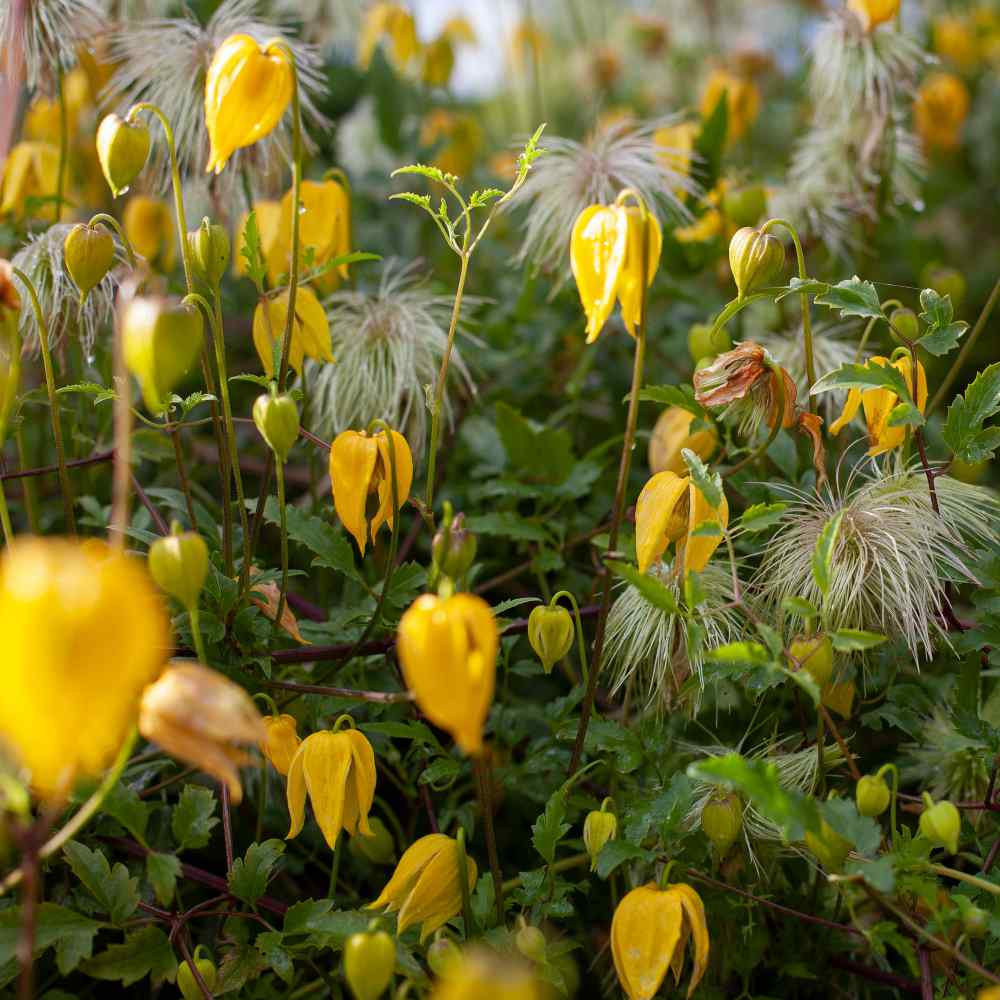
LET160 Golden Clematis ( Clematis Tangutica )
This makes a wonderful, vining flower that is a long-lived perennial, normally living at least 25 years. The vine will grow about 8 feet tall if given something to climb and cling to. The top of the Clematis vine should be exposed to full sunlight with the roots shaded by either a ground cover or a mulch such as bark dust. Clematis Tangutica is tolerant of poor soil but needs to be well watered. This Clematis plant will flower within 3 – 4 months of planting the flower seeds, and the second year it will produce significantly more blooms.
The 3 inch yellow blooms also produce feathery silver seed heads. This vine is great for trellises and arbors, and also does well in containers as an annual. This Clematis plant will both summer and fall. Zones 5-9.
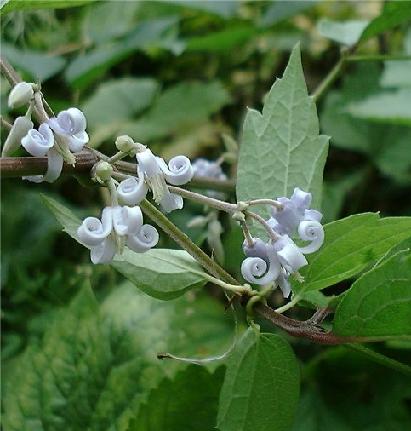
W213 Japanese Blue Bell Clematis ( Clematis stans )
New! Japanese origin vine, soft blue bell-shaped flowers. Climbs up to 8 ft tall, hardy for zones 4-9.
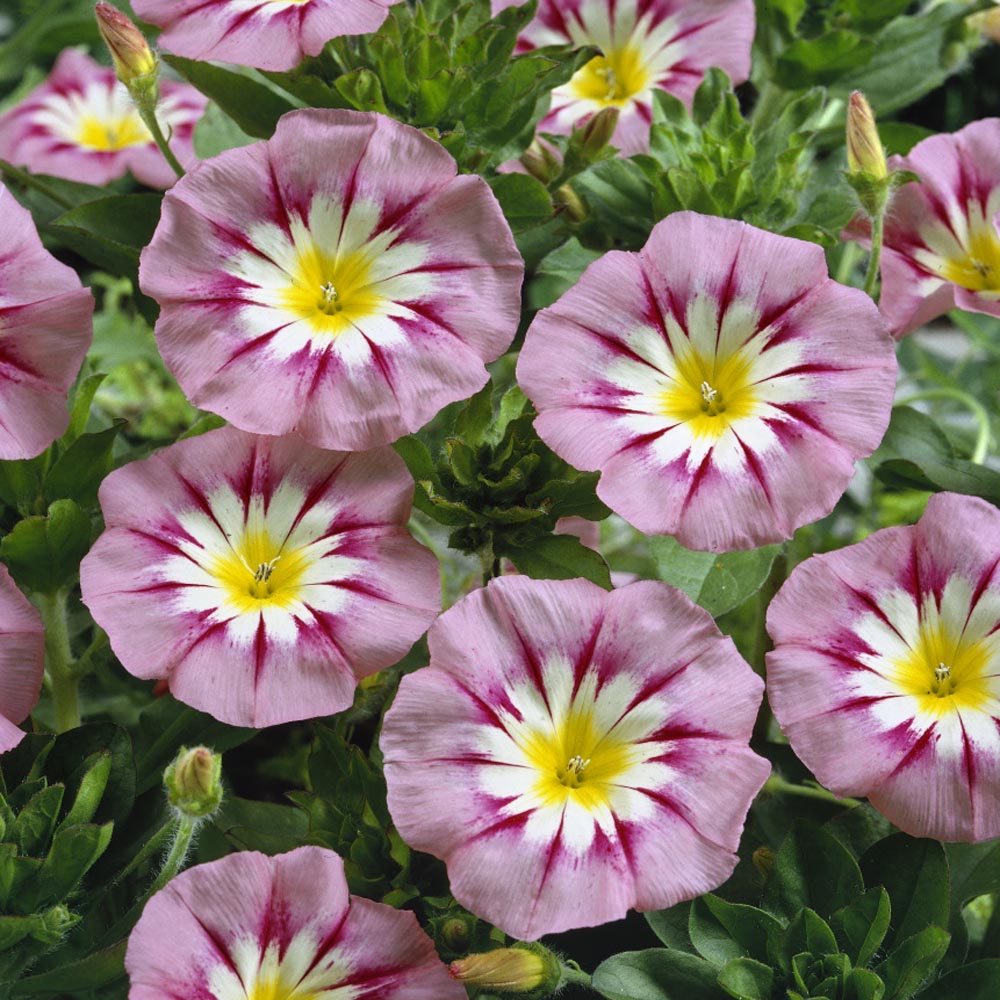
SF339 Dwarf Morning Glory Rose Ensign
Convolvulus Tricolor. Grow Dwarf Morning Glories easily and quickly from flower seeds. Convolvulus tricolor has a mounding habit, and is well-suited as a flower bed plant where the 2 inch trumpet-shaped flowers will happily shine. Dwarf morning glory uses also include containers, baskets and window boxes. Rose Ensign features blooms that are tri-colored with rose and a yellow throat surrounded by a white edge. Plant seeds after soaking the seeds overnight.
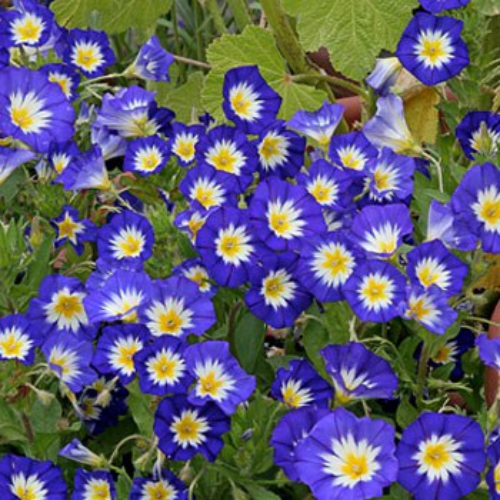
LET290 Dwarf Morning Glory Royal Ensign
Convolvulus Tricolor. Grow this deep blue mounding variety from seeds for colorful, hardy, compact bedding plants. Convolvulus Tricolor Ensign is also perfect for containers or window boxes. Royal Ensign features 2 inch trumpet-shaped blooms that are tri-colored with deep blue, a yellow throat and surrounded by a white edge. Blue Dwarf morning glory is a delight to see spilling over the edges of a planter box.
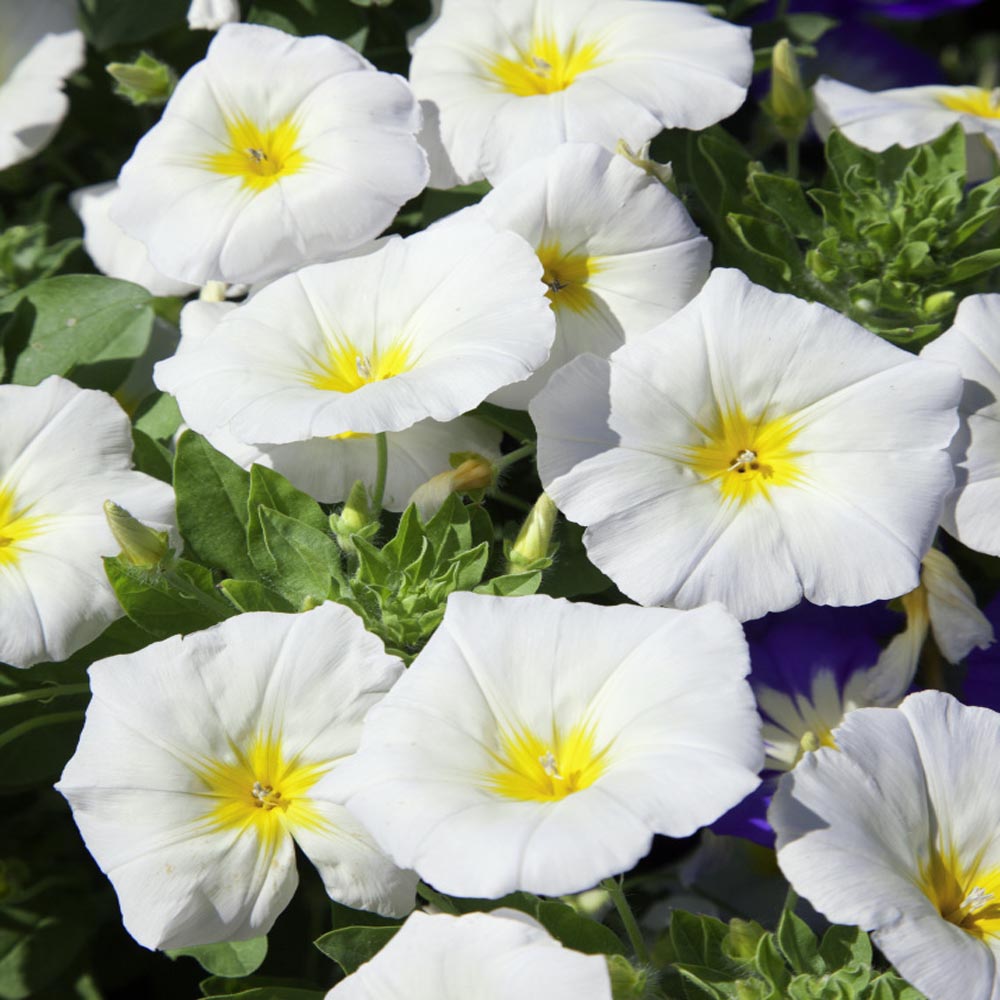
LET291 Dwarf Morning Glory White Ensign
Grow this white flowering and mounding variety from seeds for colorful, hardy, compact bedding plants. Start the flower seeds over a larger area and create a lovely white Convolvulus ground cover. This vining plant is also perfect for containers or window boxes and will spill gracefully over the edges. It features 2 inch trumpet-shaped blooms that are white with a yellow throat. Growing morning glories is so rewarding, and they are prolific bloomers that will bloom all summer until frost.
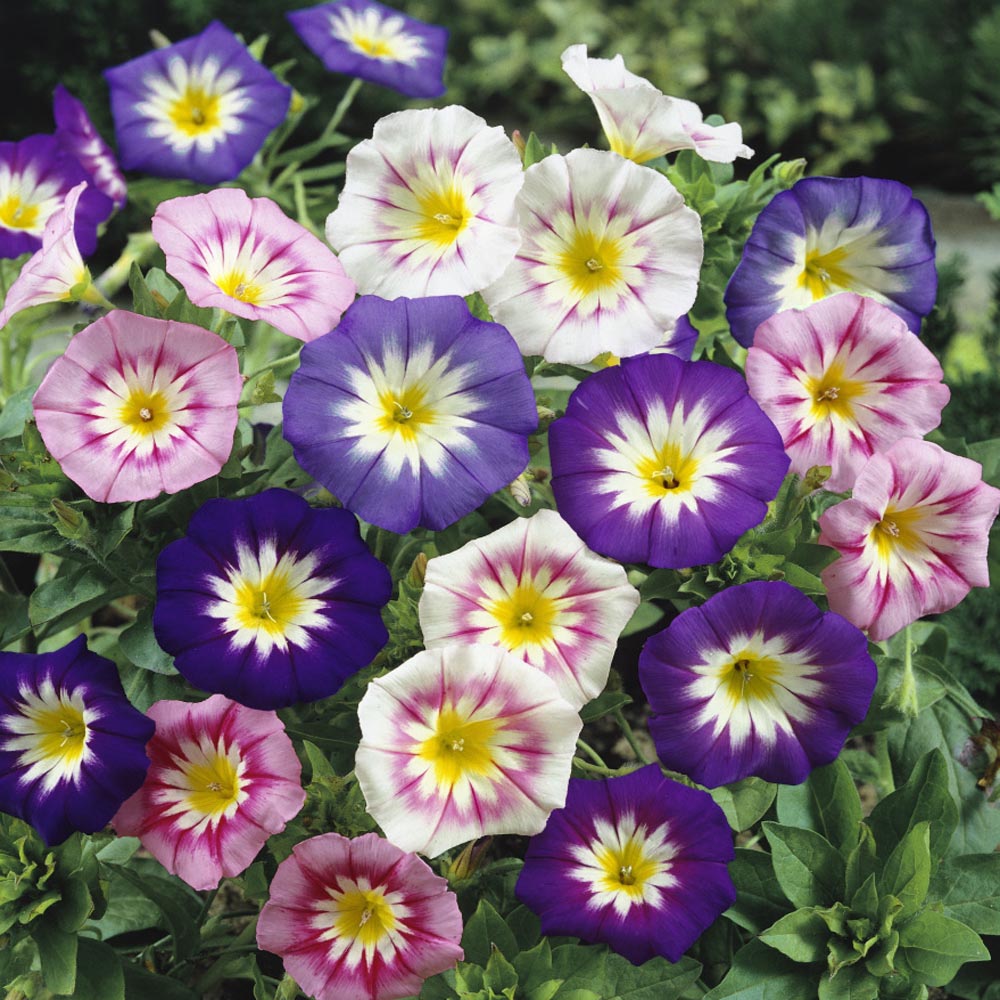
LET292 Dwarf Morning Glory Ensign Mix
Grow this mounding variety from seeds for colorful, hardy, compact bedding plants. In addition to the flower bed, use the plant in containers or window boxes. This mix features 2 inch trumpet-shaped blooms that are tri-colored. The shades range from indigo blue, lavender, red or rose with a white band and yellow throat. They are prolific bloomers and will bloom until frost. They are also liberal self-seeders, dropping their own flower seeds for next year’s display.
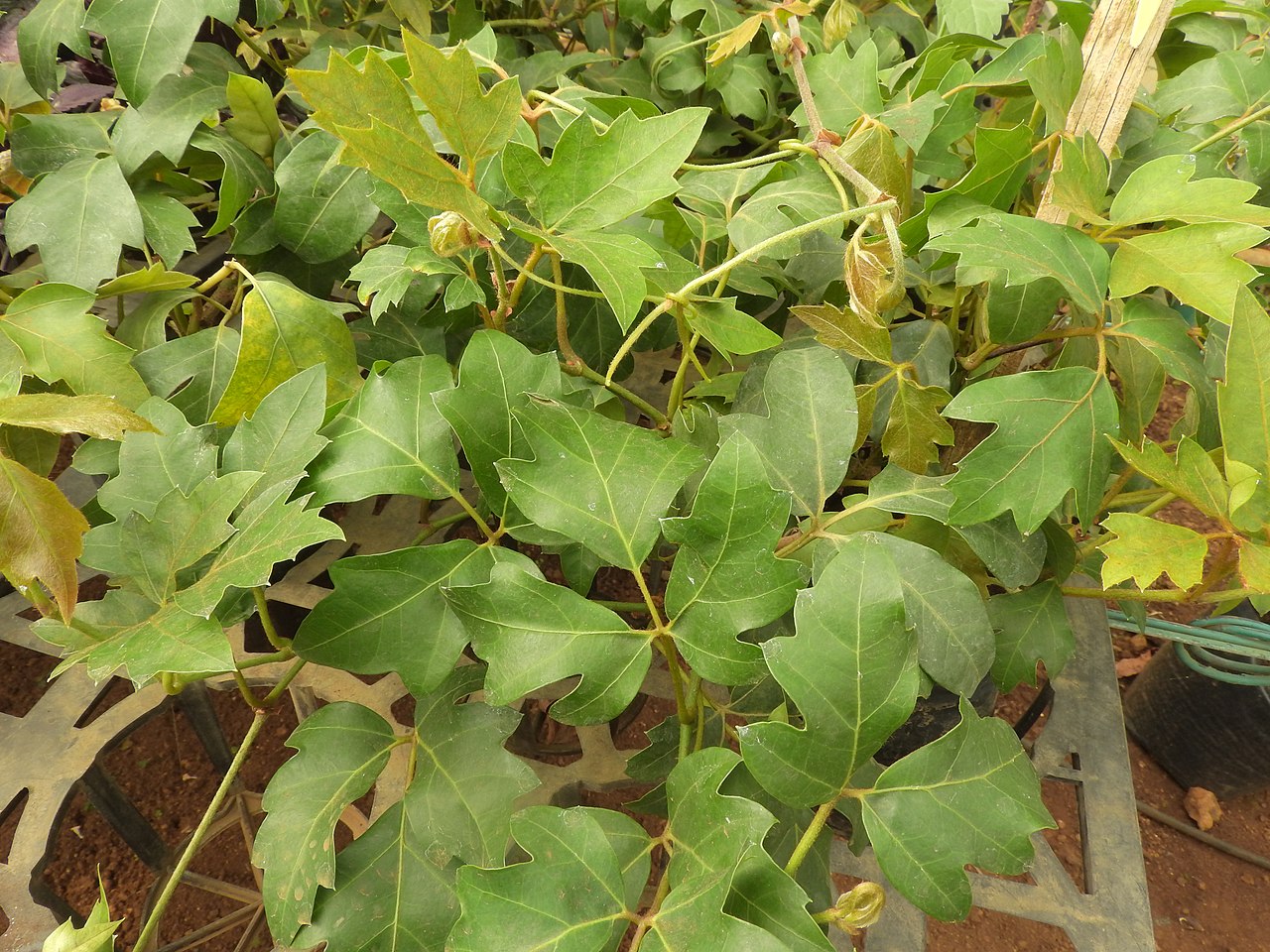
D9940 Grape Ivy ( Cissus rhombifolia )
A popular houseplant, Grape Ivy is a vigorous, evergreen vine with beautiful, glossy compound leaves. Young leaves are fuzzy, giving them a silvery sheen. It’s extremely adaptable to indoor conditions and makes an easy house plant.
You can pot this vine in a hanging basket to show off its beautiful trailing foliage. Large plants can be trained up a trellis or moss pole. Its sturdy vines will scramble up any support, climbing and clinging with its curling tendrils.
Provides a lush, tropical vine that’s easy to grow to decorate your home or office. Grape ivy is not a very fussy plant so you can enjoy its fine foliage in hanging baskets and other planters around your home.
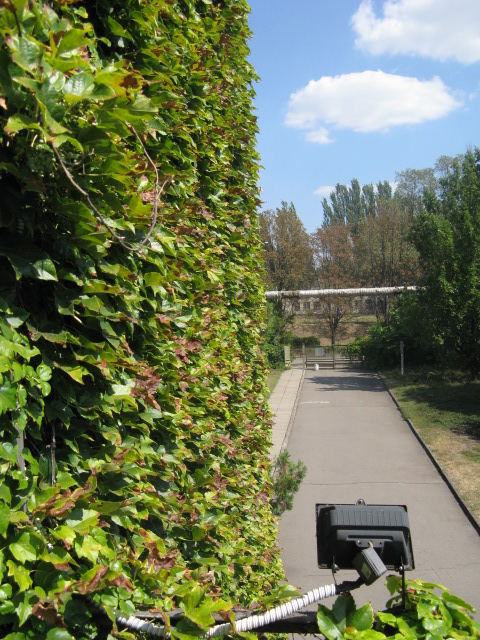
TRZ089 Boston Ivy ( Parthenocissus tricuspidata )
The famous ivy of the North that grows just about anywhere. Attractive glossy green foliage on a climbing perennial vine that will cover just about anything. It is the plant from which the term “Ivy League” derives, growing on numerous upscale campuses.
You can easily grow Boston ivy as houseplants that will climb on an indoor trellis or other structure. This is easily accomplished, as Boston ivy plants readily climb by tendrils with adhesive disks.
Boston Ivy is a sensible alternative to ivy, a perennial climbing vine that is gentler on masonry and an even more vigorous grower (its reach can top 30 feet at maturity). It is a well-behaved climber, with vines that won’t destroy your masonry or cause cracks in the facade of your house. It is best suited for zones 4-8.
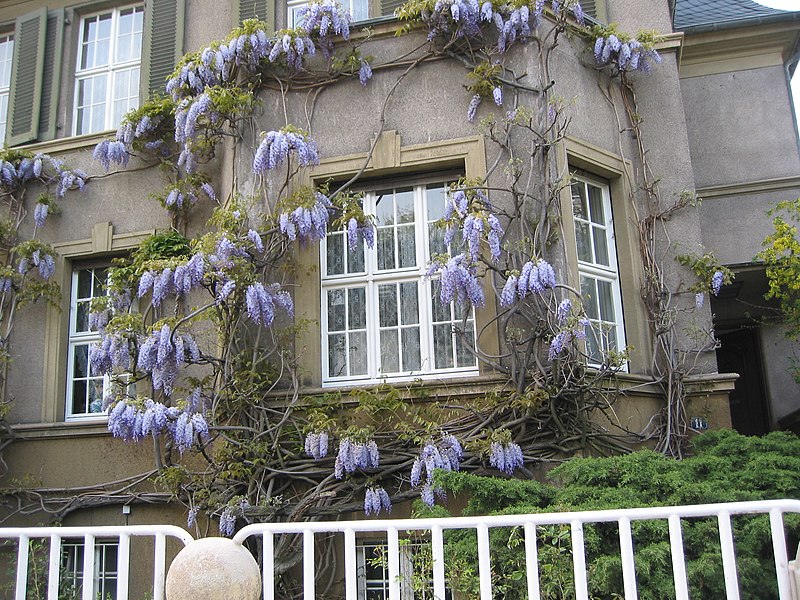
FA48 Blue Wisteria Vine ( Wisteria sinensis )
Perennial. Extremely popular vining plant that that eventually develops a thick trunk to 8′. Mature height is 25′ or more. It produces masses of violet blue flowers appearing before the leaves. The racemes of flowers hang to 1 1/2′ or more providing colorful
display. The pinnate leaves are divided into 13 leaflets. Deciduous. Hardy to zone 5 and easily grown.
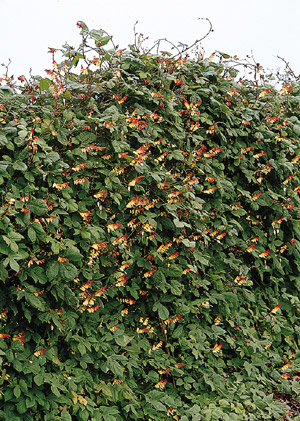
IP010 Firecracker ( Mina lobata )
Annual. This member of the morning glory family produces masses of dazzling 1.5 inch tubular flowers that mature from soft lemon yellow, through orange and deep rusty red. A plant in full bloom will never be forgotten! Incredibly showy, it deserves to be the focal point of your flower garden. Grows to 10 feet or more tall. Annual.
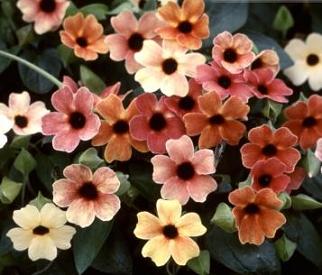
IM091 African Sunset
Annual. A unique variety of Black-Eyed Susan Vine ( Thunbergia ).
Vigorous twining climber, ideal for hanging baskets or as a climbing plant or bedding plant. Colors range from deep brick-red to soft cream with many shades of pastel reds, pinks, oranges and yellows in between, with dark eyed centers. Individual flowers may change color as they age. Native to the mountains of Western Kenya.
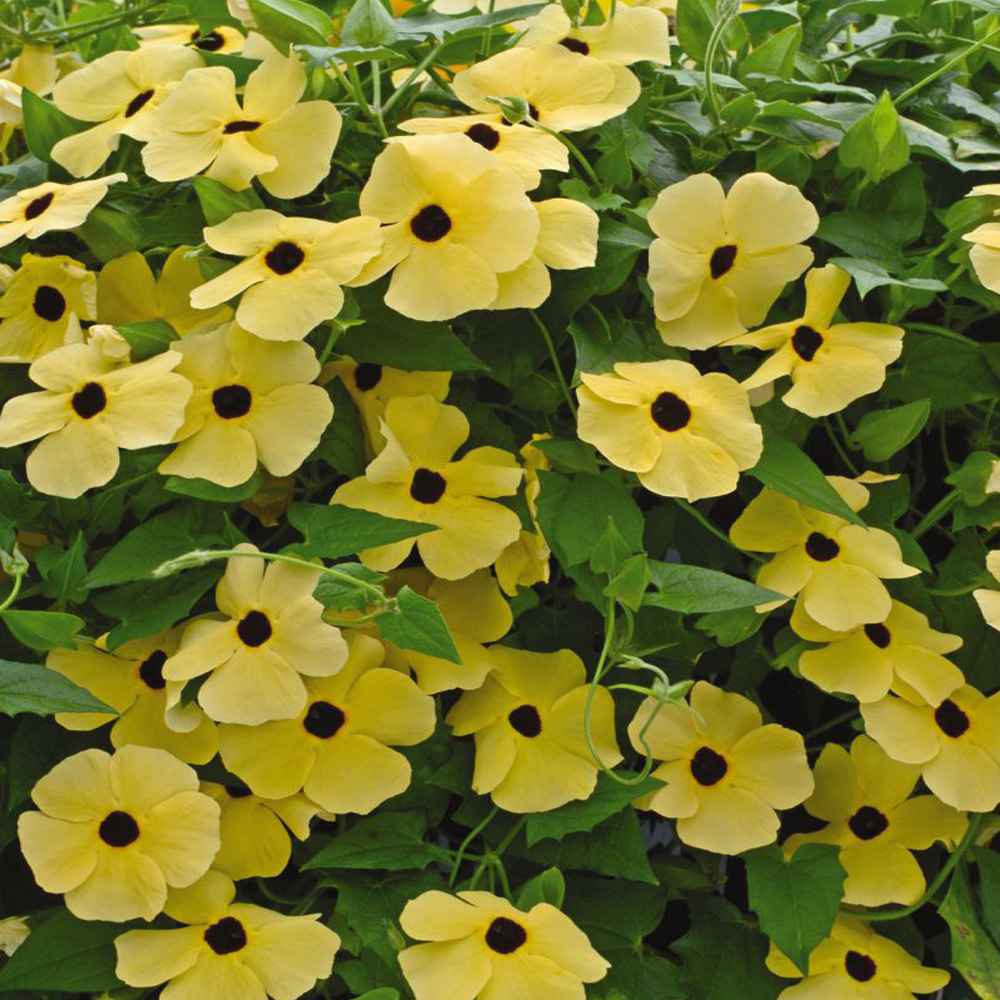
IM092 Susie Yellow-Black Eye
Annual. A unique variety of Black-Eyed Susan Vine ( Thunbergia ). Well branched vigorous climber for large pots with stake or trellis, easy to grow.
This distinctive flowering vine broadens the color range of thunbergia,this Susie can “pop” into flower in as little as 6 weeks, and is excellent in hanging baskets or window boxes.
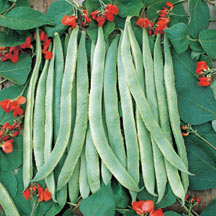
TCB063 Scarlet Runner
Old-fashioned favorite perfect for the kitchen garden. Multi-use bean with edible blooms, tender young pods and beautiful shell/dry beans. Bright scarlet flowers have a sweet, fresh taste and are attractive to hummingbirds.
Prolific ornamental variety with light green, flat pods 12-16″ long which are fine flavored when young and tender. Large shiny black and purple mottled seeds are tasty as a shell or dried bean. 80 days.
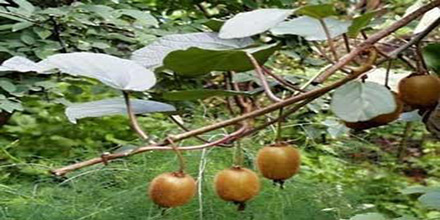
D8509 Kiwi Fruit ( Actindia chinensis )
Cold hardy to zone 4. Kiwis are vigorous vines. They cannot
support their own weight and will spread up to 30 feet. They
require strong support such as trellis, arbor, or fence. In
nature, they grow up into trees. Training to the south side of
a building is excellent for the small planting. Kiwi vines are
heavy feeders and like their roots to be in warm soil. A mature
kiwi vine can produce 200 pounds of fruit.
Kiwis require special training and pruning to produce good
crops. When planted, the vines should be pruned back to 4 or 5
buds. From these a main stem should be selected and staked to
grow to the top of the arbor or trellis, usually 6-7’
high. The trellis should be strong to support the heavy future
fruit loads.
Kiwis are beautiful vines. Their vigorous spring growth is a
spectacular sight. Excellent for a privacy screen, they will
rapidly cover a fence and with support will cover a wall or
steep slope. Kiwis grow in a manner similar to grapes but more
rapidly. They are very high in Vitamin C. (Ten times as much as
lemons.) They are excellent for eating fresh and are a tasty
addition to salads and desserts. Ice cream, pies, jam and wine
are other ways to use kiwis.
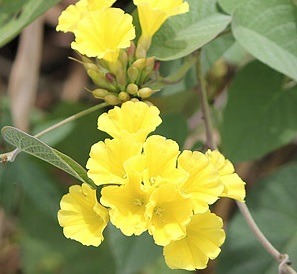
SF250 Hogvine ( Merremia umbellata )
This relative of the Woodrose family is a perennial vine that is extremely hard to find in the US. Growing to 15 feet and showing off these beautiful sprays of cascading yellow flowers throughout the summer make this vine a keeper. Attracts birds, butterflies and bees. Hardy in zones 8-11. Especially nice to grow over a trellis or privacy fence and will grow in full sun or part shade, producing more blossoms in full sun. It is well suited for pot culture in warm greenhouses. Perennial. Widely used for it’s medicinal properties in India.
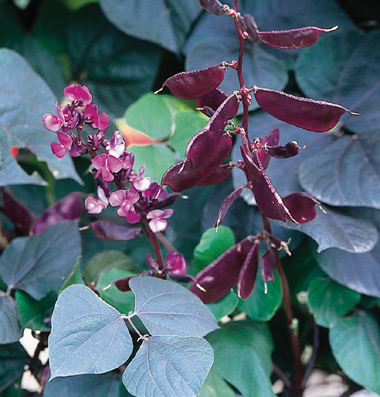
SF152 Ruby Moon ( Dolichos Lab-Lab purpureus )
Annual. A showy climber with green and wine-colored foliage, fragrant lilac-rose flowers and shiny, magenta 2-3 inch pods.
Blooms and pods can used for cutting. Twining growth to 10-20 feet tall.
Perfect for trellises, arbors, walls or fences. Perennial in zones 9 and 10, it can be grown as an annual everywhere.
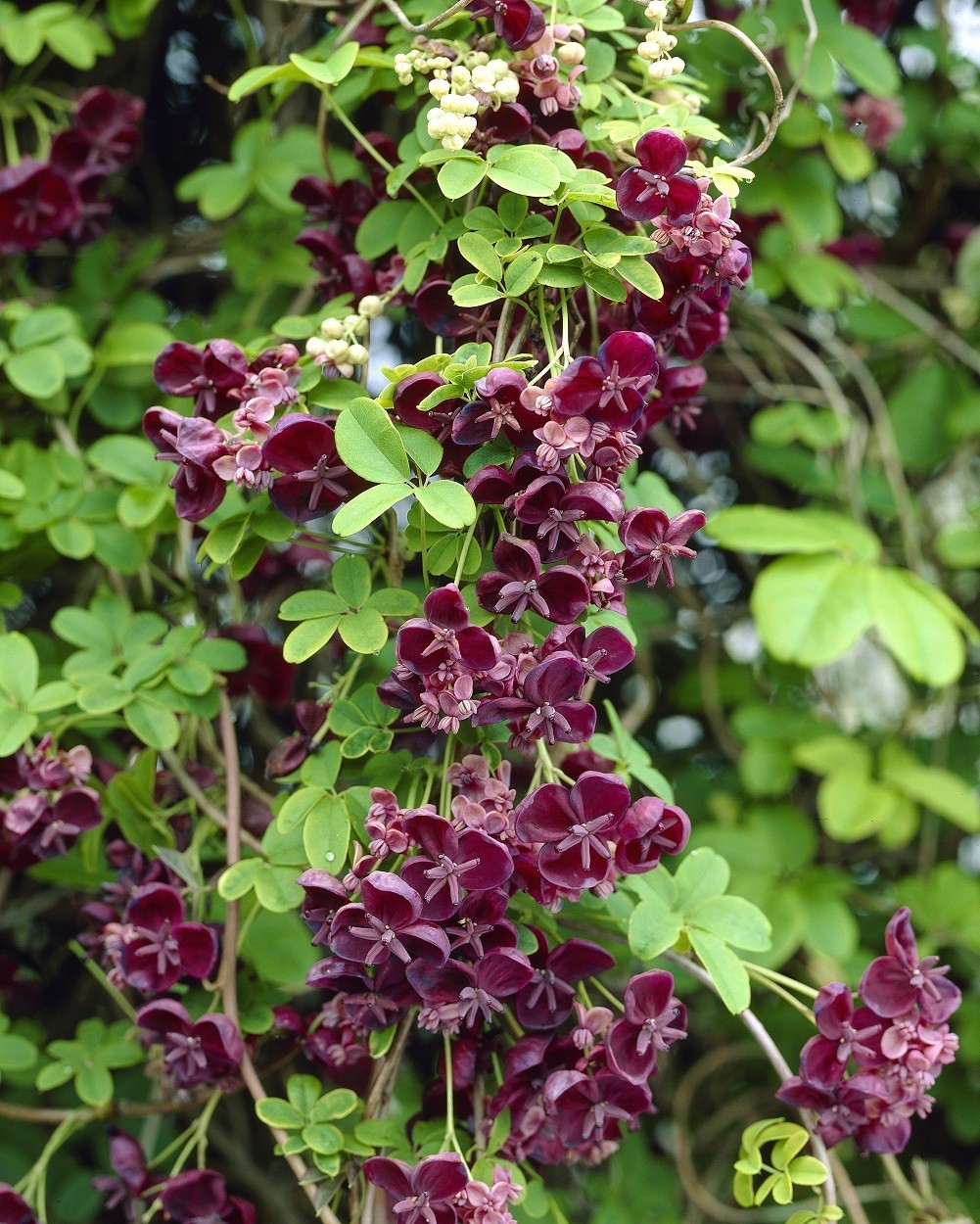
SF185 Chocolate Vine ( Akebia trifoliata )
Perennial. Also known as Three Leaf Akebia. An attractive climber with twining stems. Deciduous palmate leaves are divided into three wavy edged leaflets. Stems are violet when young and brown at maturity. Small deep purple flowers (both male and female) are borne in clusters in May and have a delicate cinnamon scent.
Very interesting edible fruits, resembling a sausage in shape and reaching 4-5″ long. May be grown in full sun or partial shade. All Akebia species retain their attractive leaves through most of the winter, are excellent for growing on walls, fences, trellis.
Best planted in a sheltered position. It can be trained up various kinds of garden supports, or alternatively, allowed to climb up a tree. Hardy to 24 degrees.
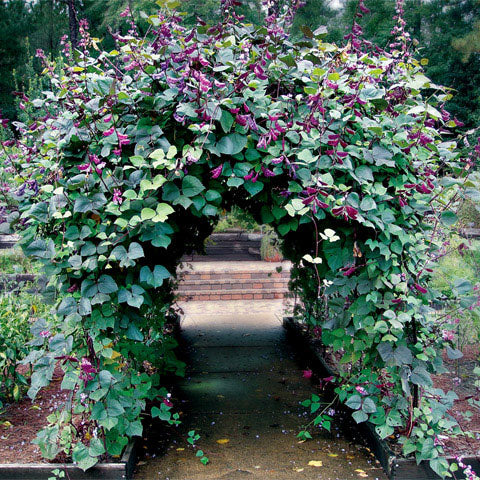
D9606 Hyacinth Bean ( Dolichos Lab-Lab )
Annual. Lablab bean is a twining vine with leaflets in threes and showy
bright purple flowers and pods. In frost-free areas the vine
becomes woody and can reach more than 30′ in length. In zones 9
and colder, the vine remains herbaceous and rarely exceeds 10′.
The leaflets are purplish-green, broad-oval or triangular in
shape and 3-6″ long. The flowers are pea-like, a rich,
brilliant purple, and arranged in loose clusters on long stems
that extend above the foliage. The pods are just as showy as
the flowers. They are flat and curved, about 3″ long and bright
purple.
Easy to grow in poor, acidic to alkaline soils. Lablab beans
take 90-150 days from sowing to maturity. Immature pods can be
picked sooner. Needs full sun for best growth. Requires
well-drained soil. Once established, lablab bean is drought
tolerant, more so than most beans.
Young immature pods are cooked and eaten like green beans
(older pods may need to be de-stringed). They have a strong,
beany flavor and some people like to mix them with other beans
or green vegetables. Unfortunately, the purple color disappears
during cooking. Young leaves are eaten raw in salads and older
leaves are cooked like spinach. Flowers are eaten raw or
steamed. The large starchy root tubers can be boiled and baked.
The immature seeds can be boiled and eaten like any shelly
bean. Dried seeds should be boiled in two changes of water
before eating since they contain toxic levels of cyanogenic
glucosides. In Asia the mature seeds are made into tofu and
fermented for tempeh. They are also used as bean sprouts.
Lablab bean is a good choice for a quick screen on a trellis or
fence. It grows fast, has beautiful, fragrant flowers that
attract butterflies and hummingbirds, and it even produces
edible leaves, flowers, pods, seeds and roots. Each summer I
train a vine or two of lablab up the clothes line pole just for
the color and fragrance.
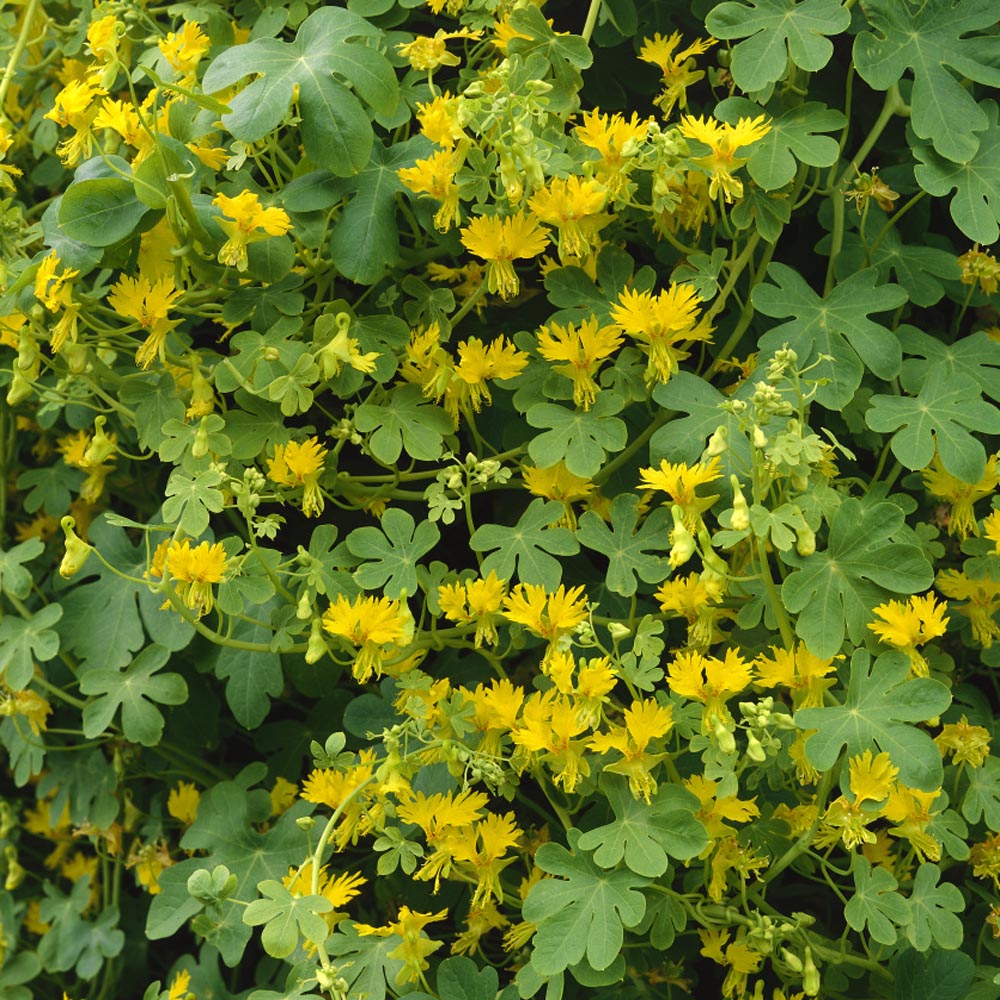
D8575 Canary Bird Vine ( Tropaeolum
peregrinum )
Annual vine. Lustrous canary yellow flowers on a vigorous vine with shiny green leaves. Flowers resemble small birds in flight. The flowers are edible.
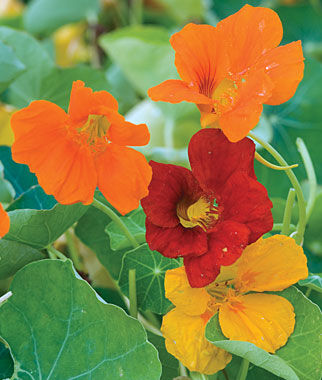
This semi-trailing Nasturtium wanders 1m (36″) and more. Large, fragrant, double and semi-double flowers come in a beautiful range of colours. Encourage it to climb by tying. Sow Glorious Gleam nasturtium seeds to fill in a large area quickly. Glorious Gleam Nasturtium seeds can be direct sown in the late spring or early summer. Try them in hanging baskets or along a rock wall. All Nasturtiums tend to self sow, but they are tender plants and easy to control. The leaves, flowers, and seeds of this nasturtium are edible, and the flowers bring a rich visual pop to salads and smart drinks. An AAS Winner in 1935.
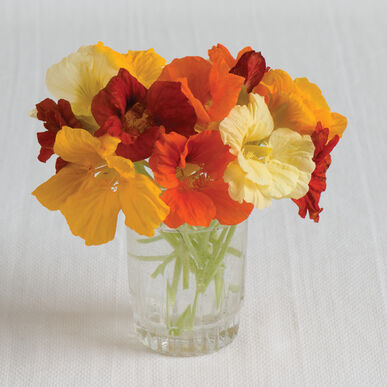
D9879 Jewels of Africa
Annual. Nasturtium with variegated foliage.
A variegated Nasturtium with a blend of yellow, red and peachy pink flower with marbled foliage, striped with cream, against a light green background. Excellent container or ground cover specimen.
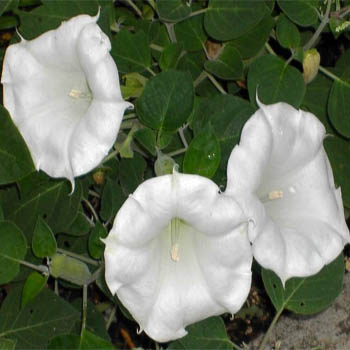
D9804 Giant Moonflower( Ipomea alba var )
Annual. The moonflower is a vigorous twining vine that is very fast growing in really hot weather. It is a tender tropical perennial but is now seeing popular use as an annual vine in colder areas.
This close relative of the morning glory has similar heart shaped leaves that are a rich green and 4-8 inches long. They provide a beautiful backdrop for the spectacular moonflowers.
This vine also known as the evening glory as its buds open in late afternoon and last only until morning’s light transforms them into a limp shriveled mass.
Moonflower makes up for the brief lifespans of individual flowers by producing quantities of the big blossoms throughout the summer. These are held on a stem that bears several buds simultaneously, not all of which bloom the same night. The long 4 inch buds are also very attractive especially in the hours just before the flower opens.
And what a fabulous flower the moon vine produces! They are fluted funnels sculpted in purest alabaster white. About the diameter of a saucer measuring 5-6 inches across.
As if the moonflower was not already enchanting enough, it also has a delightful fragrance to complement its beauty and perfume warm summer nights.
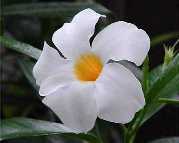
W199 Chilean Jasmine ( Mandevilla suaveolens )
Perennial. A moderately fast growing semi-deciduous slender stemmed twining vine that grows to 12 feet or more wide and high with support and develops a succulent subterranean caudex. It has luxurious 6 inch long bright green glossy leaves with a long tapering point and an abundance of fragrant white flowers in summer months.
The tubular flowers are 2 inches long and flare open to 2-1/2 inches wide with what is described as a heady vanilla aroma most pronounced in the evening but some seem not to be able to smell it at all. The flowers are followed by pairs of long bean-like fruit pods – these fruit and the fragrance cause some to call this plant the vanilla bean vine though it certainly should not be used in cooking. Plant in full to part sun (blooms best in full sun) and water occasionally to regularly. Tolerates most soils and is root hardy to at least 12 degrees (we have seen claims to below 0 degrees ) and deciduous in most California gardens as temperatures near freezing. Prune in late winter prior to new growth starting and watch for aphids on the flower buds.
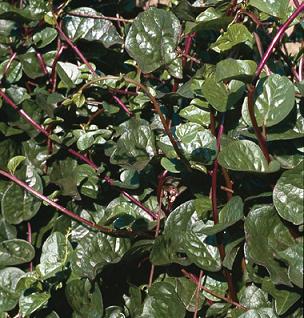
FB159 Red Malabar Spinach ( Basella rubra v Rubra )
Annual. Charming twining climber, dark red-olive leaf, purple red stem, pink flowers, vine for large pots or beds or as vegetable.
Also known as Ceylon spinach, vine spinach or Malabar nightshade. It is a climbing perennial plant, mostly cultivated as an annual vegetable against a support in home gardens but in some areas as a vine like market vegetable without staking. Malabar spinach is not a true spinach (Spinacia oleracea L., chenopodiaceae), but its leaves, which form on a vine, resemble spinach, and are used in the same way. The plant is a native of the East Indies, and found its way to the New World from China. It has spread throughout the tropical world and it is one of the best tropical spinach widely adapted to a variety of soils and climates. It is particularly abundant in India, Malaysia, and the Philippines, but it is also seen throughout tropical Africa, the Caribbean, and tropical South America.
Malabar spinach has thick tender stems and the leaves are almost circular to ovate, alternate, and short petioled. The flowers, borne on axillary spikes or branching peduncles are bisexual and inconspicuous. The fruits are fleshy and purplish black and the juice is sometimes used as a dye.
The succulent young and mature leaves, and the stems are eaten. The most common method of cooking is as a pot herb, mixed with stew or other vegetables. The leaves have mild flavor. Malabar spinach is a good source of vitamins A and C, calcium, and iron.
Malabar spinach is a perennial that tends to extend itself over time. Seeds can be sown directly or vines may be established directly from stem cuttings. These need a little shade on transplanting, but root readily. Malabar spinach can thrive under conditions of moderate soil fertility, but is quite responsive to nitrogen fertilizer. Can be harvested at 57 days after planting.
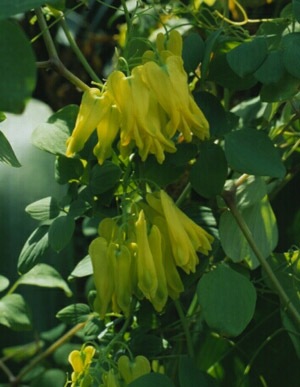
BM44 Golden Tears ( Dicentra scandens )
Bright yellow heart-shaped flowers bloom in April or May; bloom continues off and on
throughout the season. This climbing perennial can reach 3 feet high and wide. The
species is native to the Himalayas.
Grow in fertile, well-drained, slightly alkaline soil in part shade and allow to self-sow.
Provide a strong support for its tender weaving tendrils. May be grown as an annual in
cooler climates.
A hardy perennial, hardy to zone 3.
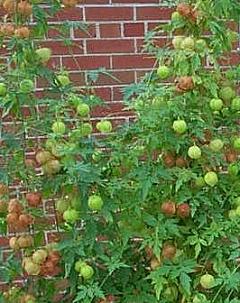
D9935 Heartseed ( Cardiospermum halicacabum )
Balloon Vine is a woody climbing plant with tendrils that grab structures like a trellis or fence, and the vine produces small white flowers which after time forms the large ornamental seed pods that resemble balloons. Cardiospermum vine can climb up to 10 feet in no time forming its remarkable inflated seed pods. The seed pods change color over time from green to red as the plant matures.
The seeds are very unique with a hard shell of dark brown to black, and each seed has a perfect cream colored heart. The flower seed gives the plant another one of its common names, Heartseed Vine. Another common name for Cardiospermum is Love in a Puff Vine.
Also known as Kanphuti. A climbing annual common throughout India. Leaves are mixed in castor oil to treat stiff limbs, rheumatism and lumbago. Root has diaphoretic, diuretic and laxative properties.
Leaf juice is used for earache. Cooked and eaten in India and Africa. Decorative black seeds with cute heart-shaped white faces are used for necklaces.
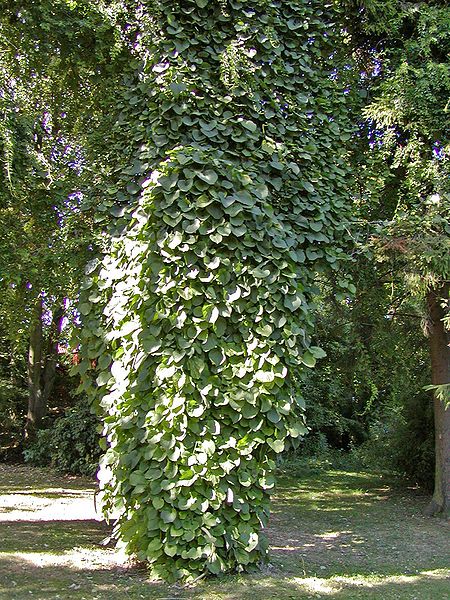
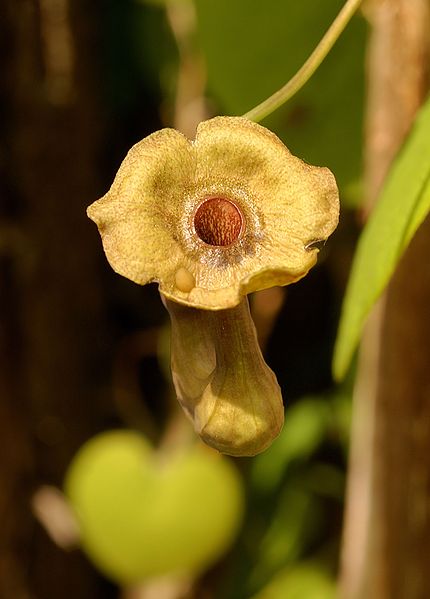
IP271 Dutchman’s Pipe ( Aristolochia durior )
Annual. A fast-growing vine excellent for screening purposes; it will quickly create a dense screen and shade. The huge 8-10 in. wide, heart-shaped leaves are dark green with a coarse texture.
Dutchman’s Pipe is a very vigorous native vine. It will create a thick green screen in a short period of time making it ideal for covering a fence, wall or strong trellis. It can grow to 30 feet tall in some cases.
It has large, dark green, heart-shaped leaves and very interesting flowers that are shaped like a small pipe. They are a few inches long and are a mahogony-cream color.
This vine plays an important role in the life of native Pipevine Swallowtail butterflies. The flowers provide nectar for the butterflies, and the leaves are an important food source for the caterpillars. The vigorous growth of this vine makes it easy to share the leaves with these beautiful insects.
This native plant grows best in moist, well-drained soil, in full to partial sun. It can reach heights of 30 feet tall. It is a good plant for having few pest or disease problems, and as a bonus it withstands urban pollution quite well.
For zones 4-8.
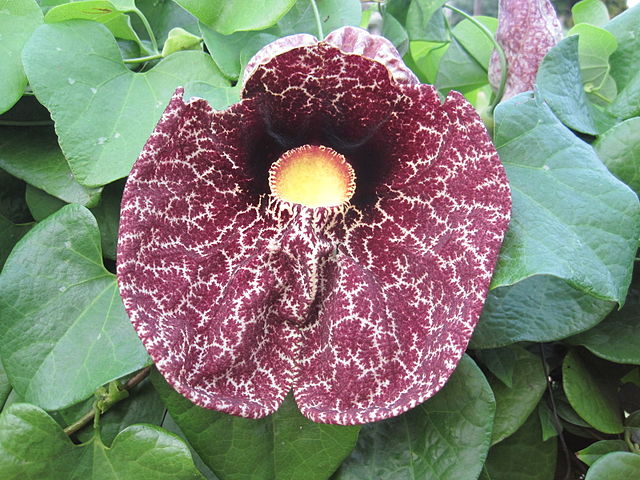
LET252 Elegant Dutchman’s Pipe ( Aristolochia littoralis )
A climbing vine that can reach about 10 to 15 feet in length. The slender stems are woody and the leaves are bright green, forming a dense attractive foliage. Flowers are heart-shaped, greenish yellow with intricate purplish-brown markings. These unusual flowers are about 3 inches long, grow solitary in the leaf axils and resemble Sherlock Holmes’s pipe (hence the common name of “Dutchman’s pipe”). The inner surface of the flared mouth is completely purplish-brown. The flowering period extends through all summer. This plant can be invasive in Florida and California, we do not ship these seeds to these states.
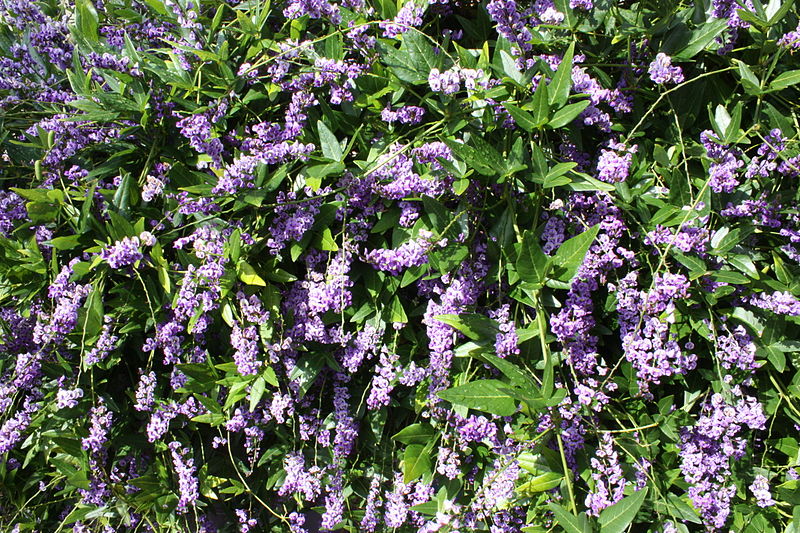
LET255 Australian Wisteria ( Hardenbergia comptoniana )
Ideal flat ground cover, can be used to scramble over fences, garages & pergolas. Thrives in moist well drained soil in a sunny, open position. A species of flowering plant in the pea family, Fabaceae, native to Western Australia. A twining vine, it produces purple flowers in the spring. It is found on sand dunes and sand plains, and in open forest, on sand- or clay-based soils. It is readily cultivated in the garden, where it does best in a part-shaded position.
It has been in cultivation for many years and is widely grown both in Australia and overseas. It has proven to be very hardy in a wide range of climates and most reasonably drained soils. It will grow in sunny or lightly shaded locations. It is usually more vigorous than H.violacea and should not be allowed to grow over smaller shrubs. It grows well on a strong support such as a fence or trellis. These are beautiful plants, especially when trained to grow on trellises and pergolas and allowed to drape down over sitting areas of the garden. Mature plants are cold hardy to about 28 degrees.
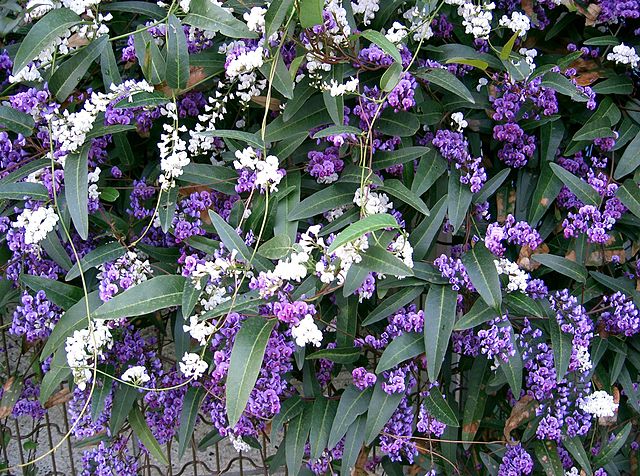
3404 Happy Wanderer Vine ( Hardenbergia violacea )
Perennial. A species of Australian flowering plant, known in Australia by the common names false sarsaparilla, purple coral pea, native lilac and waraburra (which comes from the Kattang language). It often grows as a climbing vine, but also as a subshrub if pruned.
It is used as a landscape plant in the southwestern U.S. where it is commonly called lilac vine, and occasionally Mexican lilac vine.
Happy Wanderer blooms profusely in late winter and spring with long cascading racemes like a Wisteria. The vine is much smaller at maturity and also tolerates dry conditions once established.
Purple, or occasionally pink or white, flowers to almost half inch across are borne in pendent racemes throughout much of the year.
Cold hardy to about 22 degrees.
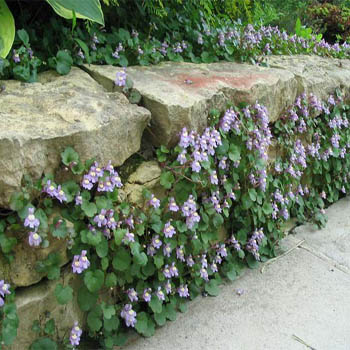
IP251 Kenilworth Ivy ( Cymbalaria muralis )
Annual/Perennial inside. With scalloped leaves, and pretty lilac colored blooms, Kenilworth Ivy makes a wonderful ground cover or hanging basket plant.
It performs well even in full shade, and it loves to cascade down a stone wall or spill over the sides of containers. The plant also makes charming hanging baskets. This trailing vine takes very little maintenance except for regular waterings, and being cut back and deadheaded before setting seeds.
It is a prolific self-sower, spreading its seeds all over the garden. To keep it more contained, deadheading is helpful. Kenilworth Ivy makes a very nice flowering ground cover plant. Ground cover plant that is also ideal for rockery. Perennial, hardy for zones 5-9, grows 4 inches tall.
Sow seeds indoors 10 weeks before the last frost is expected. Use starter trays, sow the ground cover seeds on the surface of sterile soil, gently pressing the seed into the soil.
Do not cover the seeds. They need light to germinate. After danger of frost has passed, transplant the young ground cover plants into the garden.
Average germination time is 14-24 days.
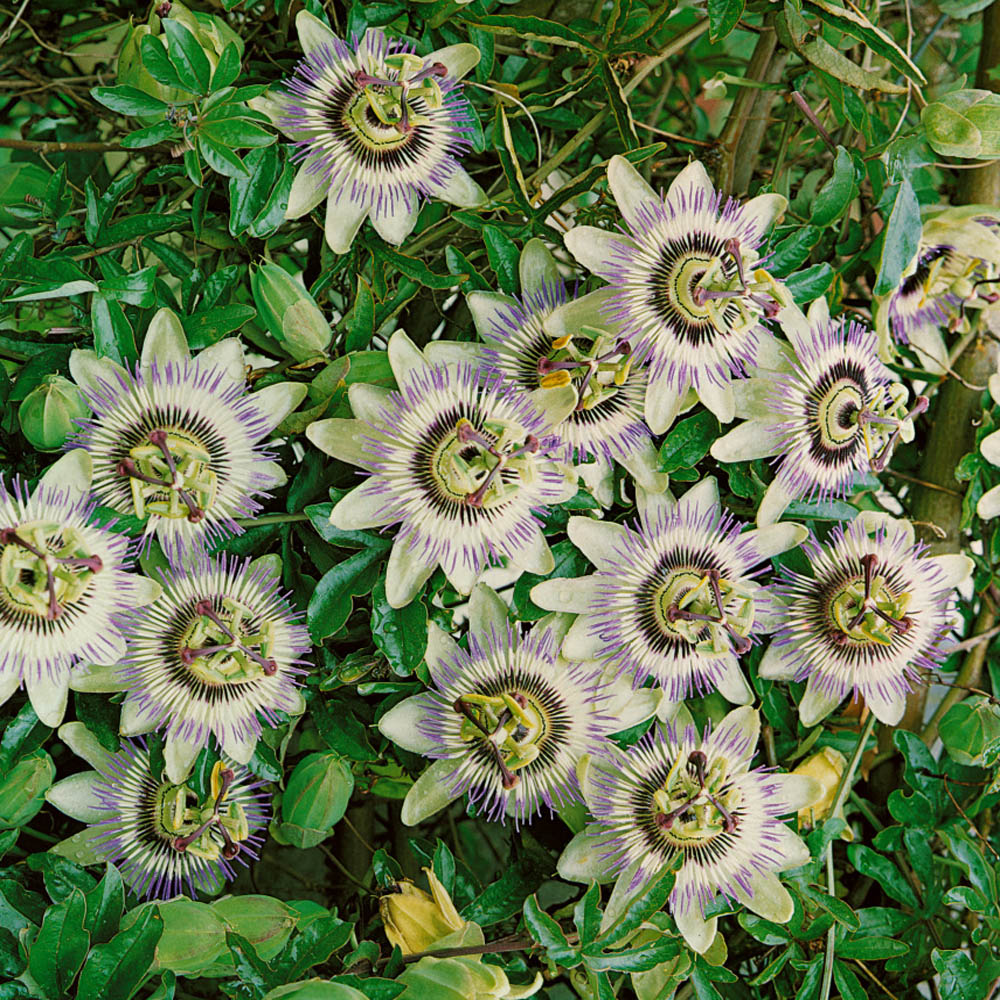
BM67 Blue Passionflower ( Passiflora caerulea )
Annual. Blue passionflower is a twining vine that can grow to 30 ft (9.1 m). The shiny leaves are usually palmately lobed with five parts, but they can have as few as three lobes or as many as nine. They are evergreen in tropical climates, but deciduous where winters are cool. The white and purple-blue flowers which appear in summer may be as large as 4 in (10.2 cm) across. They are followed by egg-size deep orange fruits from late summer through fall.
Blue passionflower likes loose sandy or gravelly soils and does best planted in old brick rubble that retains heat during cold winter weather. Too much manure or compost will result in lush vegetative growth and poor flowering. This species will flower in a small pot, but it prefers plenty of root space and will do better in a roomy container. In Zone 8-9, the ideal location is against a warm south-facing old brick wall where an overhang prevents excessive drenching by heavy rains.
Go light on fertilizer and water deeply, but infrequently; passionflowers should be encouraged to reach deep into the earth for water. When motivated to do so, they are capable of developing amazing root systems to sustain them through droughts and freezes. Passionflowers love high humidity, but they are subject to fungal diseases if they don’t get good air circulation in the greenhouse. Blue passionflower does better overwintered in a cool greenhouse where it can go semi-dormant as opposed to in a hothouse where it will be tempted to put too much energy into weak off-season growth. In either case, it is important to keep the soil on the dry side in the winter.
Blue passionflower may be wound around a hoop support to keep it within bounds so that it may be grown as a houseplant in a sunny south-facing window. Passifloras flower on new growth, so they may be pruned early in the growing season. It is best to cut some stems back nearly to the base, rather than just trim the tips. The terminal buds may be pinched out to encourage branching. Always keep some green foliage on the plant to keep the sap rising and encourage rapid regrowth. The roots may be weakened and become subject to fungal infection if too much top growth is removed at once. Don’t try to train a passionflower to be too neat and compact; branches allowed to hang loose and droop a bit will be the ones most inclined to flower. Passionflowers are subject to a wide array of pests and diseases, but most of them have minimal impact on well grown plants. Butterfly larvae are the exception; caterpillars readily devour the foliage of healthy mature plants.
Passionflowers like full sun and will scramble over trees and shrubs to get it.
Hardiness: USDA Zones 8-11. Blue passionflowers will regrow from deep roots after even severe freezes. They have been known to survive temperatures as low as 5 degrees when the ground was frozen over two feet deep! It is nevertheless important to keep the soil as warm as possible, especially in the winter greenhouse.
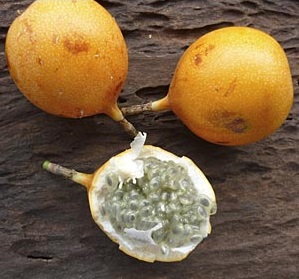
IP189 Sweet Granadilla ( Passiflora ligularis )
Annual. A vigorous vine that is woody at the base and climbs onto structures or high into trees using tendrils with heart-shaped 4 to 8 inch long leaves that are of a medium green color and paler below with prominent veins. In the warmer months of the year appear the 4 inch wide sweetly fragrant flowers, often in pairs at the leaf base. These flowers have greenish white sepals and light pinkish-white petals with 2 ranks of filaments that are banded with bluish purple.
The outer shell is hard and slippery, and has soft padding on the interior to protect the seeds. The seeds, which are hard and black, are surrounded by a gelatinous sphere of transparent pulp. The pulp is the edible part of the fruit and has a soft sweet taste. It is very aromatic and contains vitamins A, C, and K, phosphorus, iron, and calcium.
Winter Hardiness: 25-30° F
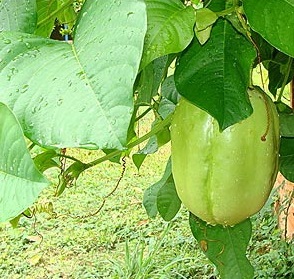
2640 Giant Granadilla ( Passiflora
quadrangularis )
The Giant Granadilla forms a larger leaf and is a more vigorous
grower than the yellow passion fruit. This plant derives its
botanical name from the fact that the stems are quad rangular
in cross section. It is a vigorous grower that can grow 50 feet
or more in a single season, for zones 10 and higher, or warm
greenhouses.
Fruit of the giant granadilla reach a length of up to 12 inches
and turn yellow when mature. The pulp around the seeds is used
to flavor ice cream and to make a cooling drink. In addition,
the flesh of this fruit is edible. The green fruit is boiled
and eaten as a vegetable. The fully ripe flesh is eaten alone
or in combination with such fruits as papaya and pineapple
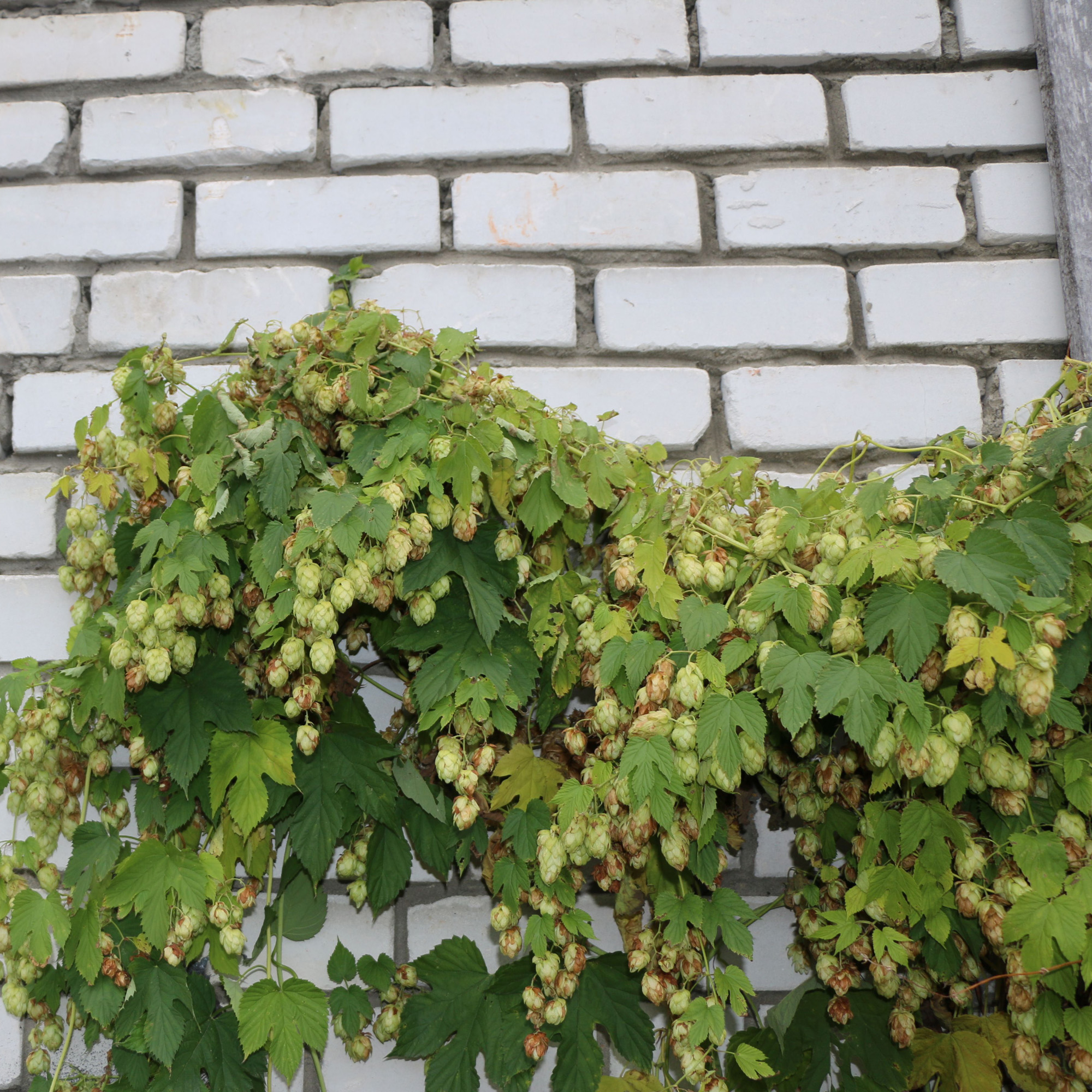
2903 Hops ( Humulus lupulus )
Hops produce rich, heavily scented, green-golden fruit that is harvested in autumn. The flowers of Humulus lupulus contain the chemicals myrcene, myrcenol, resin, linalool, humulene and tannins, all used extensively in the pharmaceutical industy. Also, another common usage is flavoring for the beer industry.
Hops seeds can be slow to germinate. Use a process called “cold scarification” to encourage hop seed germination. A good method is to put seeds in an equal amount of moist sand and refrigerate from one to three months at about 41 degrees F. After that, plant the seeds at 68 degrees F. for one to two months. If the hops seeds have not germinated, put them back in the refrigerator and repeat the cycle.
Decorative fast
growing vine, excellent for porches and screens.
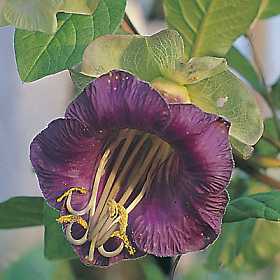
2237 Royal Plum Cup and Saucer Vine ( Cobaea scandens
)
5 Months of Blooms! Flowers mature from green to rich purple.
Statuesque vine sports outrageously large and glamorous-looking blooms along its length that can extend more than 20 feet. Extremely vigorous and puts on a great show when staked in large containers. Buds open creamy green, then change to rosy-violet and mature to a rich purple.
Height: 10-20′
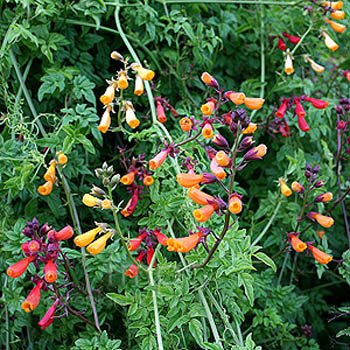
W184 Chilean Glory Vine ( Eccremocarpus tresco mix )
If you want hummingbirds in your garden, start Chilean Glory Vine plants! Chilean Glory Flower or Glory Vine is a fast-growing, evergreen climbing vine. The Glory Vine has tubular flowers that grow in clusters and are in colors of orange, yellow, pink, and shades of red. A long bloomer, Chilean Glory Flower has flowers from spring to autumn. The leaves are light green, small, oval-shaped and boldly veined. This climbing vine will quickly cover a trellis or arbor and makes a wonderful display in the landscape.
This is the perfect flowering plant for hummingbirds, and they visit it all day long. Chilean Glory Vine looks delicate, but it is vigorous and easy to grow and is considered a perennial in USDA Zones 9 – 10, but it will grow like an annual in colder zones. For areas with a long growing season, start the Eccremocarpus Scaber seeds directly outdoors in a prepared seedbed. In colder zones, start the flower seeds indoors 6 – 8 weeks before the end of frost season.
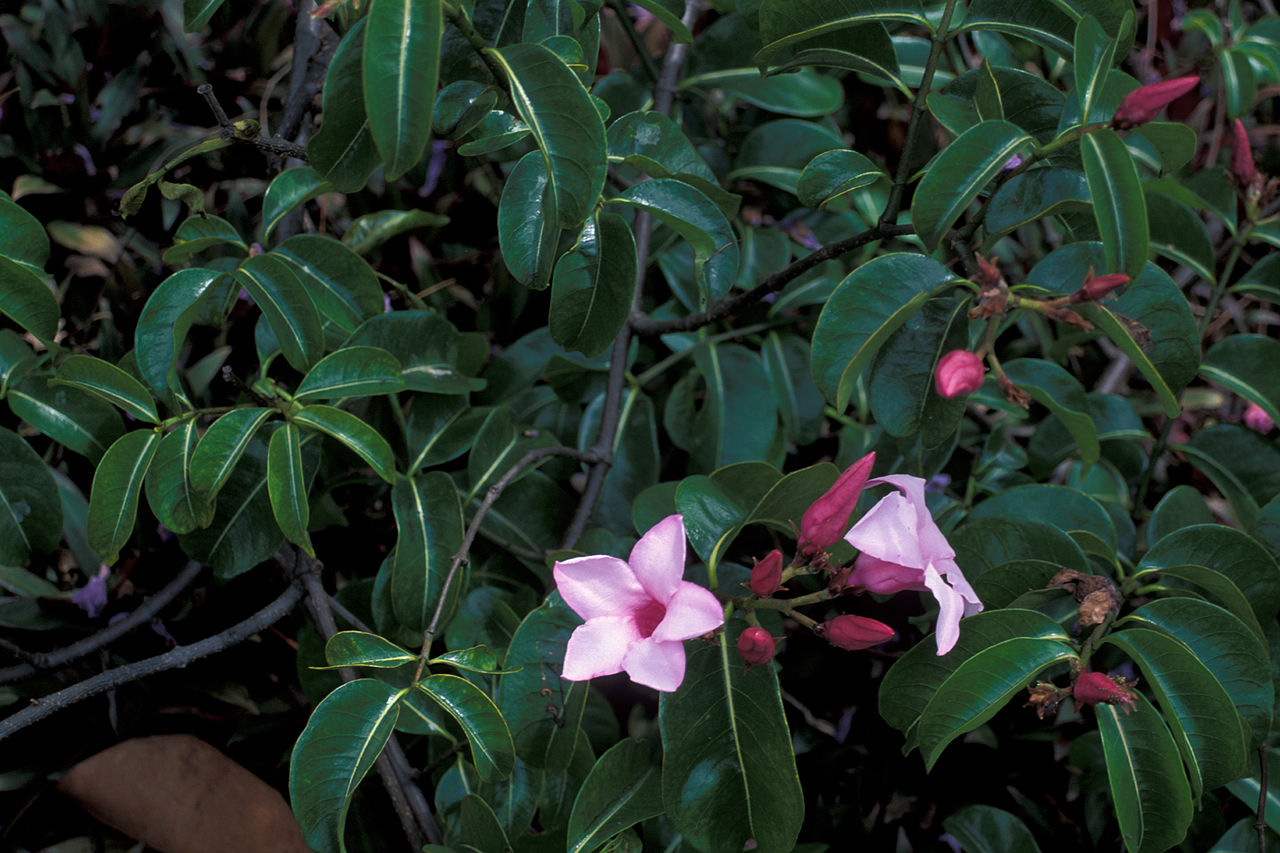
D9914 Madagascar Rubber Vine ( Cryptostegia madagascariensis )
A perennial climbing vine with attractive pinkish purple flowers. It is one of the fastest growing plants in the world, sometimes in the tropics extending by as much as 15 feet in a month. It’s sap, or latex, when treated contains commercial quality rubber. The plant can be pruned and grown as a hedge. It is very good at hiding old fences, buildings, etc.
Sap is said to be toxic to livestock, so be careful if planting outside. For warm climate or greenhouse. Zone 9 or higher.
It is considered invasive in tropical climates, so we do not ship to HI, CA or FL

IP073 Artic Kiwi, Siberian Gooseberry ( Actinidia
arguta )
A strong-growing vine with dense, dark green foliage. The
fragrant but inconspicuous white flowers appear in early
spring. The fruit, which ripens in late summer or fall, is
about 3/4″-11/4″ long. It tastes much like the commercial kiwi
fruit, to which it is closely related, but is somewhat sweeter
and has smooth skin. The seeds are very small and not
noticeable, so eating the fruits is somewhat like eating large
seedless grapes. Most selections should be hardy to around
-30° F. In the native Asian habitat of this species the
vines typically grow wild in trees, where they are known to
climb as high as 100′.
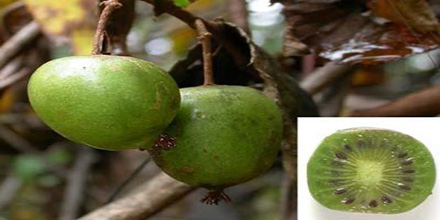
D8581 Issai Kiwi ( Actinidia )
Small 1″ fruits with a very sweet taste. The vines will grow vigorously and bears loads of small fruit that is great for salads, desert or jelly. A vigorous, fast-growing, deciduous,
woody vine that grows 25-30′ but can fill a 200 sq. ft. trellis in time. Grown for its foliage and edible fruit. Foliage is a lustrous dark green throughout the growing season. Flowers appear in May-June and are slightly fragrant and greenish white, but are not particularly showy since they are largely hidden by the foliage. This cultivar does not require a separate male pollinator plant. Smooth-skinned kiwi fruits ripen in early fall and are the size of a large grape. It tastes similar to, though slightly sweeter than, its
larger-fruited relative, the true kiwi, Actinidia deliciosa, which can not be grown north of Zone 8.
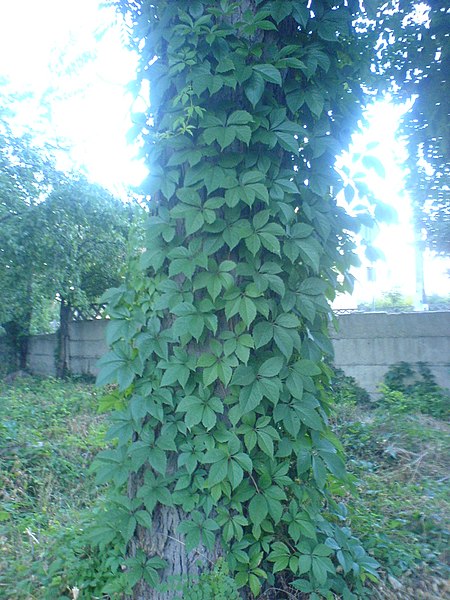
D8537 Virginia Creeper Vine ( Parthenocissus
quinquefolia )
Perennial. Virginia creeper is a fast-growing, high-climbing vine that attaches itself with tendrils which expand, disk-like, on their tips. The deciduous leaves are palmately compound with (typically) five leaflets radiating outward from a central petiole (leaf stem) like spokes on a wheel.
Each leaflet is about 3″-7″ long and an inch or two wide. The leaves turn fiery red in fall and are very showy. The individual flowers are tiny and inconspicuous, and arranged in elaborate long-stemmed clusters, with each flower at the tip of its own peduncle (flower stem); such an inflorescence is called a cyme. The whole inflorescence is about 4″-6″ across. The berries are blue-black, less than a half-inch across and much relished by birds.
Native to eastern North America, from Quebec to Florida, and west to Texas. Hardy throughout USDA Zones 3-9. Virginia creeper occurs in all kinds of woods and in clearings and on hedge rows. There are another 9 or 10 species of Parthenicissus in Japan and China.
Easy to grow, Virginia creeper can get out of hand if not managed. It will send up sprouts and seed itself, and established plantings may smother shrubs and trees. Virginia creeper will thrive in most soils, in sun or partial shade, with or without a structure to climb on. Grow in different shades of light (filtered) shade; part sun; full sun.
Virginia creeper is favored for its brilliant fall foliage and as a manitenance-free ground cover. When allowed to clamber over trees or other tall structures, it develops elongated leafy festoons that are especially showy. Where there is nothing to climb, it attaches to the ground with adventitious roots, and makes an excellent cover for slopes or other places where grass is not practical or desired.
( Our thanks to
www.floridata.com for use of the photo )
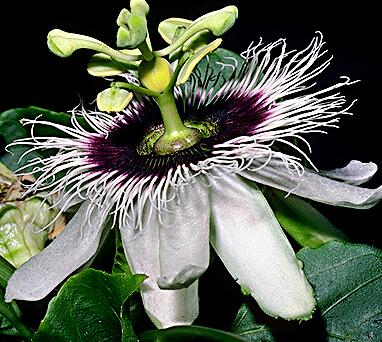
D8564 Passion Fruit ( Passiflora edulis )
Grown as annual. Zone 7 and higher. This vine, native to the Amazon, produces
beautiful flowers and sweet-tart fruit. It was named by the
Spanish missionaries in South America who saw the Passion
(suffering) of Christ represented in its flowers. Passion fruit
is widely grown throughout the tropics and subtropics. The
fruit is produced on a woody vine from bisexual flowers. The
fruit is somewhat tart, has a hard purple or yellow rind, and
contains many black seeds. Passion fruit is commonly used in
beverages. Grow on fences or trellises, or allow it to scramble
over shrubs and trees.
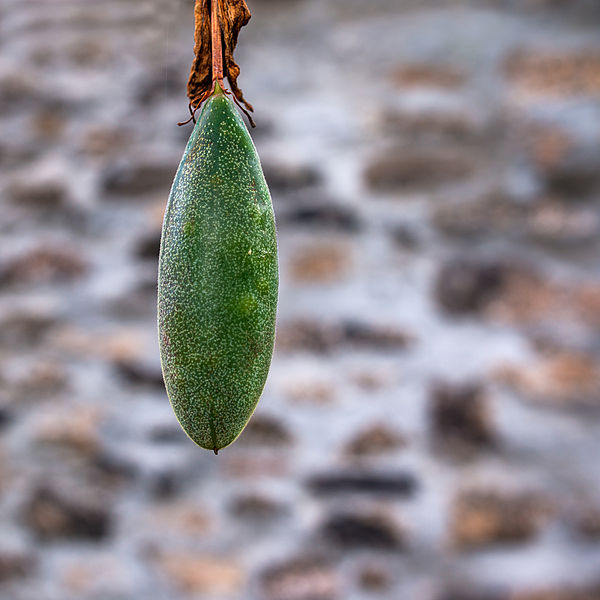
D8587 Banana Passion Fruit ( Passiflora
Mollissima )
For warmer zones, can be greenhouse grown, or in tubs on patio.
A beautiful vine with large 3-lobed leaves followed by edible
yellow fruits 4″ in length. Cannot ship to HI.
Source link













